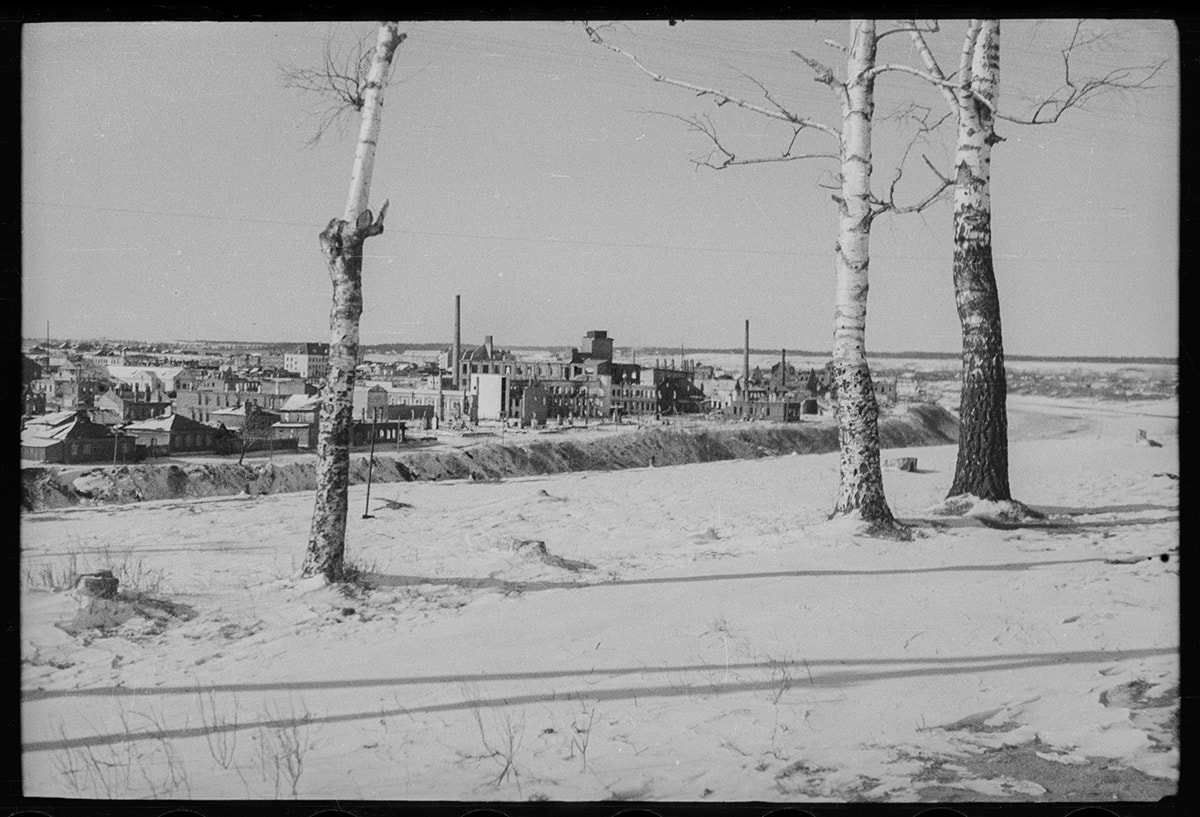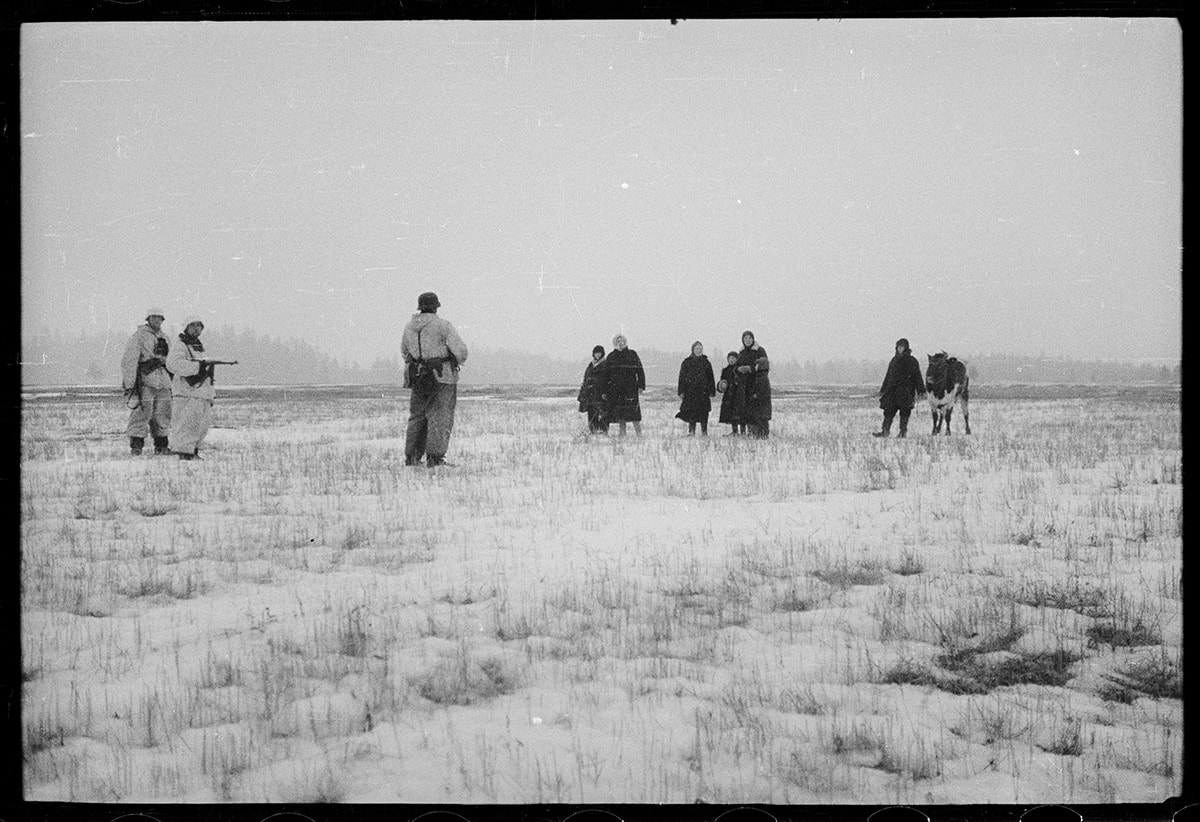
Raids on partisans and occupied Belarus. Winter 1941-42
Raids on partisans and occupied Belarus. Winter 1941-42
These unknown negatives came to my attention at an auction in Germany, April 2022. "Films from the Eastern Front" as the seller said, were three tightly twisted rolls of German Agfa black and white film. Two of them had a small piece of paper inside. On the yellowish from time to time piece of paper, most likely cut out of the manual to the German camera, with a pencil and the hand of the photographer was signed "Vitebsk. Partisan hunt" (ger. Witebsk partisanenjagd).
All images were taken by a German amateur war photographer, whose name remains unknown, who served in a Luftwaffe (German Air Force) unit with the rank of Oberfeldfebel. Between 1941 and 1942, his unit was stationed in the occupied territory of Belarus. Together with the German airborne forces, their main task was to fight the partisan movement, which was gaining momentum and becoming a serious problem for the German army. On the pictures, which were taken by an amateur photographer, one can see how German paratroopers in winter uniforms and camouflage jackets raided partisans, detained and interrogated the local population, checked and burned village houses.
In the winter of 1941-42 there were very severe frosts, unusual for the Germans. On the photos it is clearly visible from the frozen tree crowns. To build and insulate their houses, the Germans dismantled neighboring village houses. And to feed their horses, they took the straw off the roofs. At this time it was Catholic Christmas, the first Christmas the Germans celebrated on the Eastern Front. In the German headquarters, located in one of the village houses, the Germans set up a Christmas tree with candles. A poster with a picture of Hitler and the inscription "Hitler the Liberator!" can be seen on the wall. The photographer takes several self-portraits as well as group portraits of German soldiers together with cheerful local girls, some of whom are dressed in German overcoats.
The photographer's unit has the additional duty of guarding a section of railroad carrying German tanks for the further advance eastward. One of the images shows passing railroad platforms loaded with German Panzerkampfwagen IV medium tanks in winter camouflage.
At some point, perhaps during a vacation or excursion, the photographer finds himself in the occupied city of Vitebsk since July 1941. The photographer captures the half-ruined winter city and the life in it. On the pictures you can recognize: Zamkovaya Street, St. Nicholas Cathedral, St. Anthony's Church, Nativity Church, obelisk to the heroes of the Great Patriotic War of 1812 and many ruins of bombed and burned buildings. Along the Dvinskiy Bridge, which the Germans rebuilt fairly quickly, one can see the active movement of German equipment. The city itself is full of German soldiers and ruins of destroyed buildings, among which local women and children are wandering.

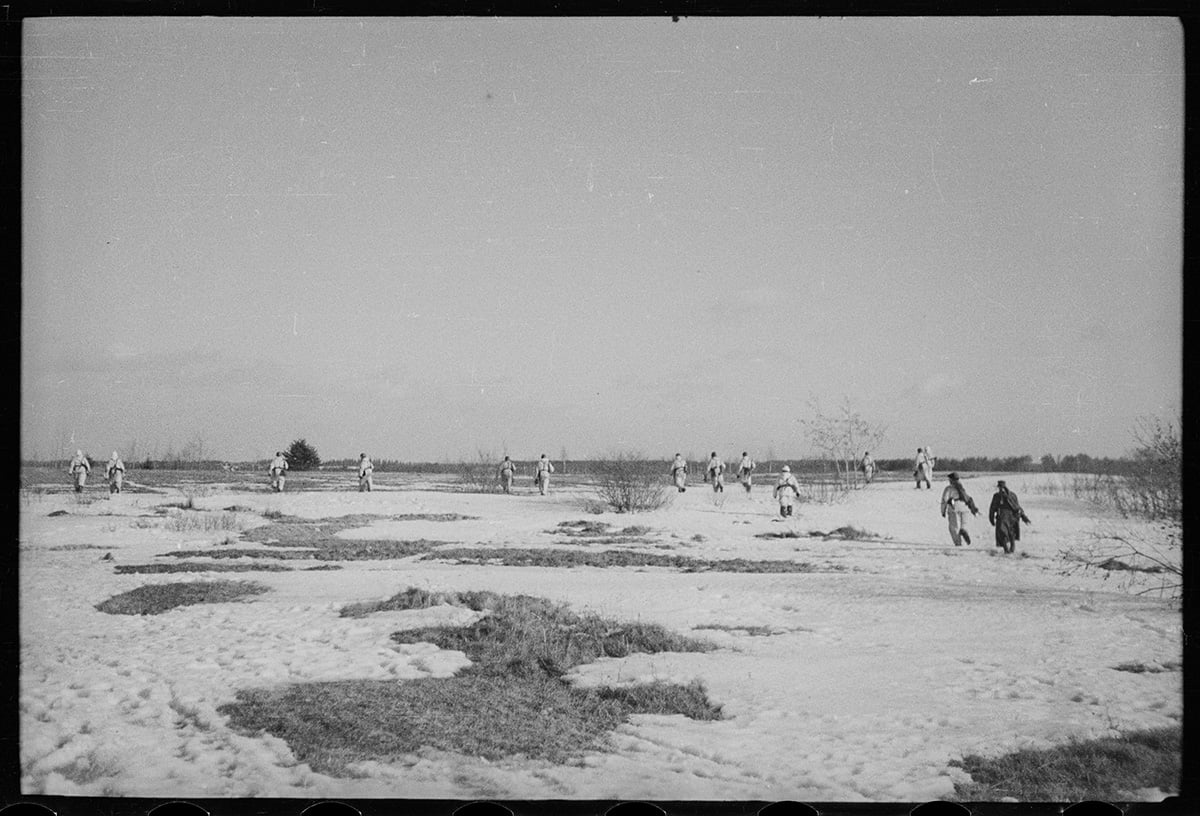
German soldiers in winter uniforms combing fields during a raid on partisans. Vitebsk region, Belarus, USSR. Winter 1941-42
German soldiers in winter uniforms combing fields during a raid on partisans. Vitebsk region, Belarus, USSR. Winter 1941-42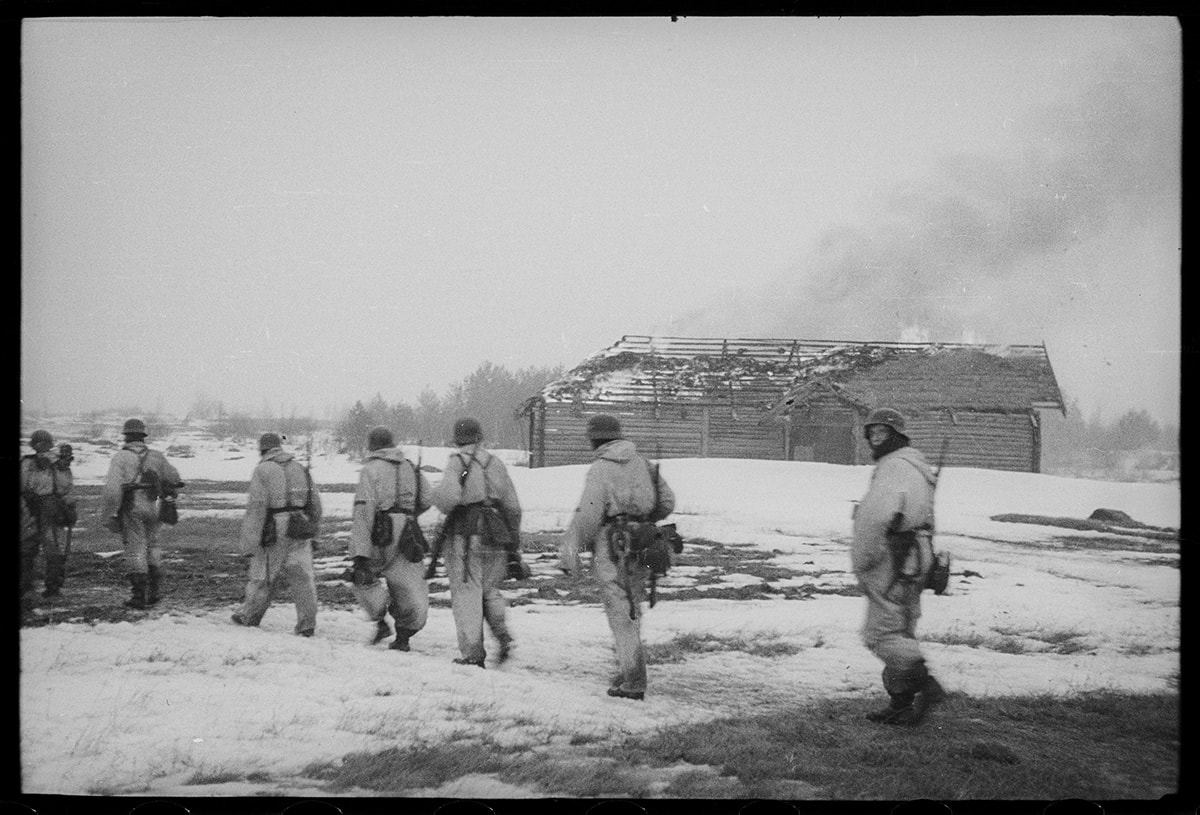
German paratroopers in winter uniforms conducting a raid on partisans. In the background, a village house set on fire by the Germans burns. Vitebsk region, Belarus, USSR. Winter 1941-42
German paratroopers in winter uniforms conducting a raid on partisans. In the background, a village house set on fire by the Germans burns. Vitebsk region, Belarus, USSR. Winter 1941-42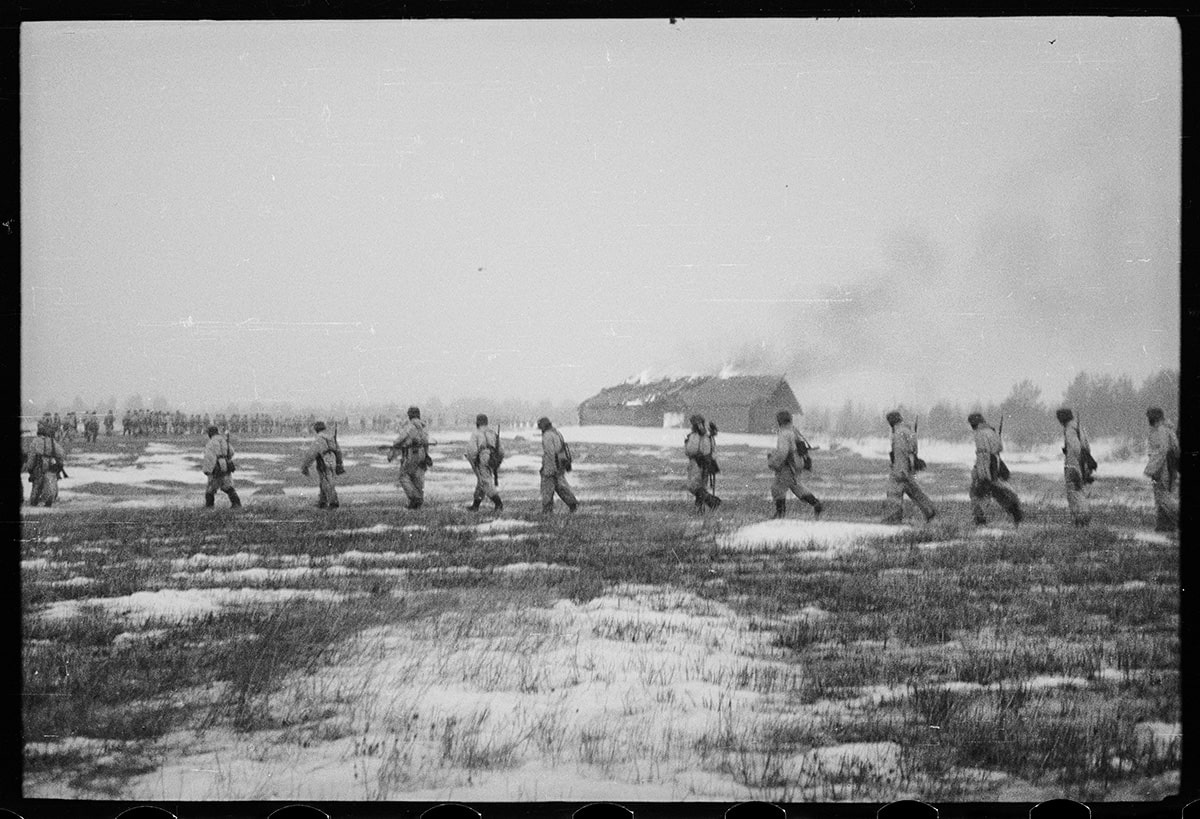
German paratroopers in winter uniforms conducting a raid on partisans. In the background, a village house set on fire by the Germans burns. Vitebsk region, Belarus, USSR. Winter 1941-42
German paratroopers in winter uniforms conducting a raid on partisans. In the background, a village house set on fire by the Germans burns. Vitebsk region, Belarus, USSR. Winter 1941-42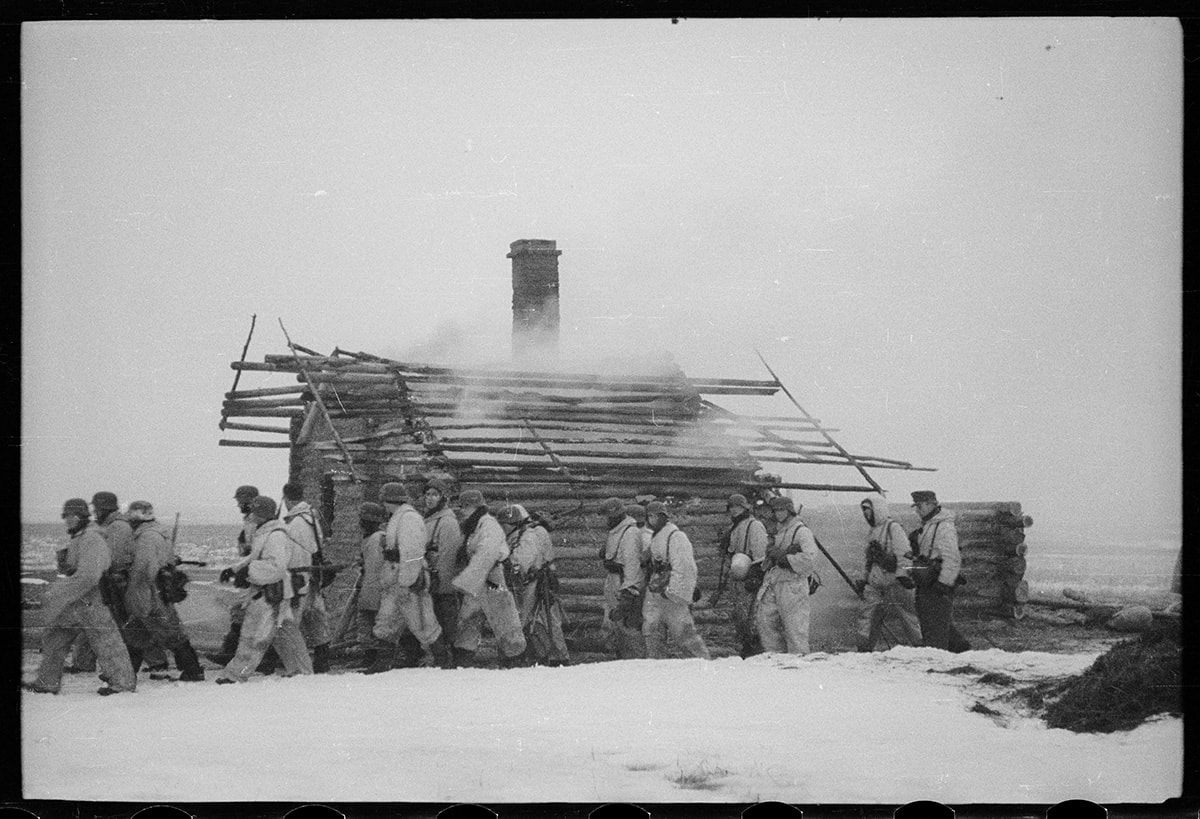
German paratroopers in winter uniforms conducting a raid on partisans. A burnt village house smokes in the background. Vitebsk region, Belarus, USSR. Winter 1941-42
German paratroopers in winter uniforms conducting a raid on partisans. A burnt village house smokes in the background. Vitebsk region, Belarus, USSR. Winter 1941-42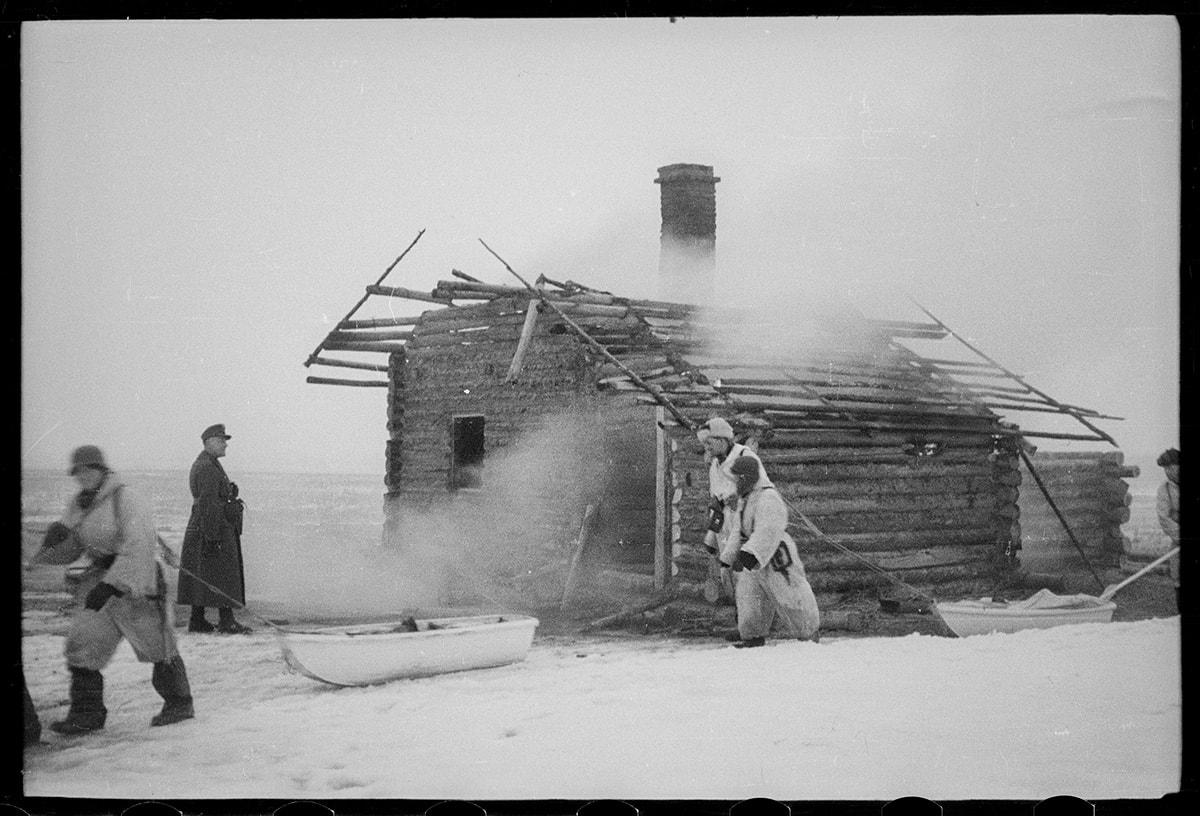
German paratroopers in winter uniform pass by a burnt village house during a raid on partisans. Vitebsk region, Belarus, USSR. Winter 1941-42
German paratroopers in winter uniform pass by a burnt village house during a raid on partisans. Vitebsk region, Belarus, USSR. Winter 1941-42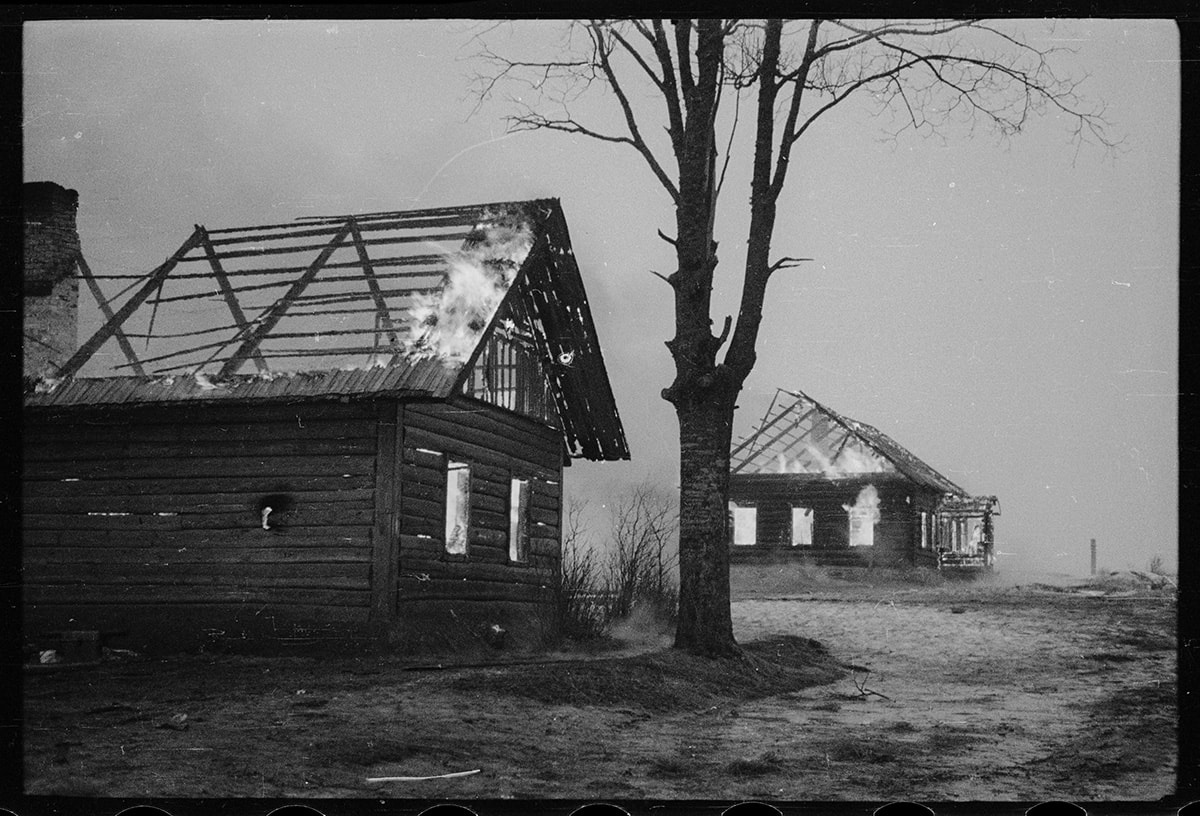
Village houses set on fire by the Germans during a raid on partisans. Vitebsk region, Belarus, USSR. Winter 1941-42
Village houses set on fire by the Germans during a raid on partisans. Vitebsk region, Belarus, USSR. Winter 1941-42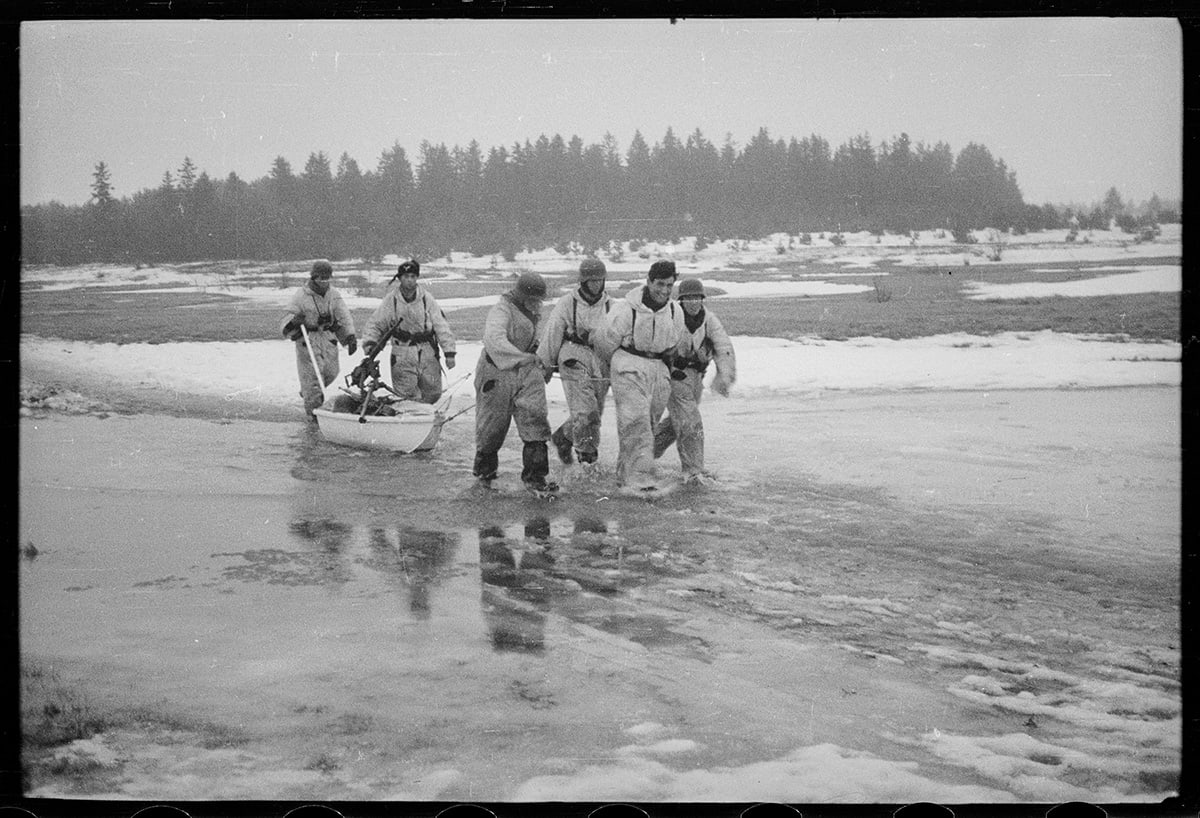
German paratroopers in winter uniform pulling a cradle with a captured Soviet Degtyaryov DS-39 machine gun and other weapons through melted snow. Vitebsk region, Belarus, USSR. Winter 1941-42
German paratroopers in winter uniform pulling a cradle with a captured Soviet Degtyaryov DS-39 machine gun and other weapons through melted snow. Vitebsk region, Belarus, USSR. Winter 1941-42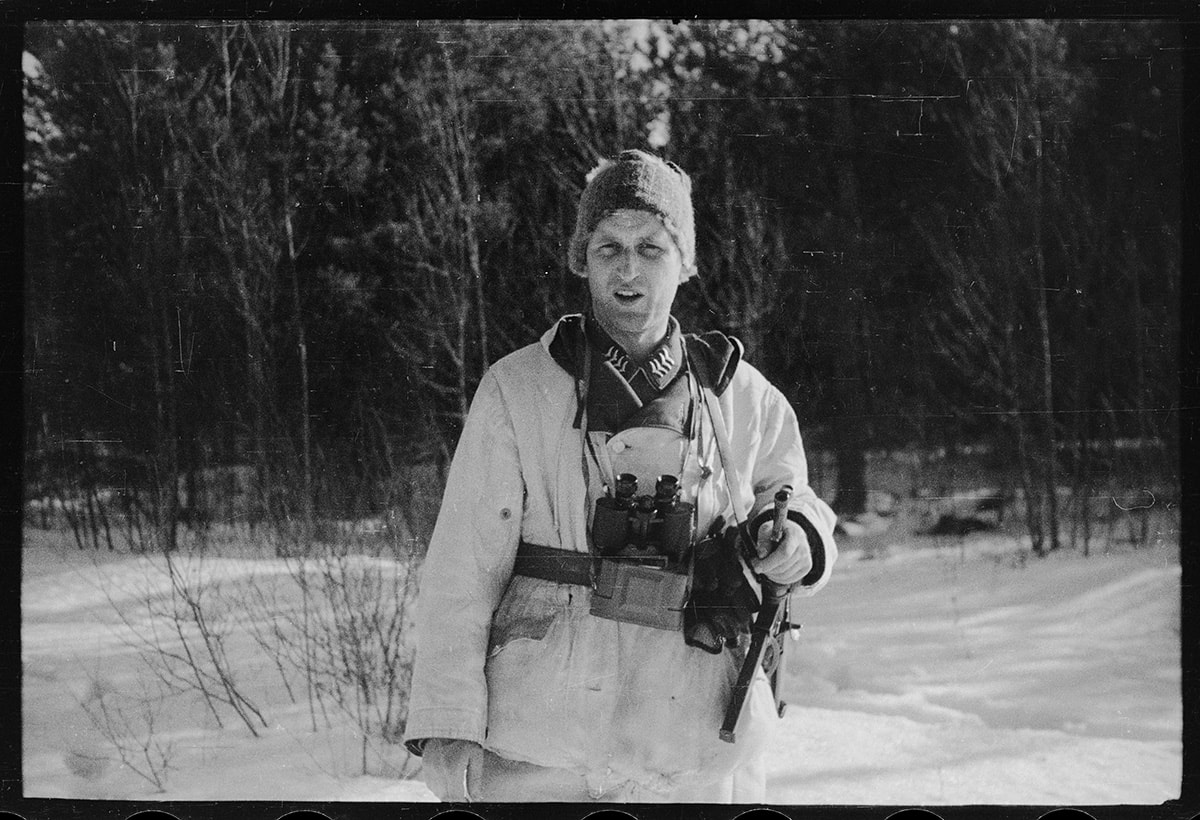
Portrait of a Luftwaffe Oberfeldwebel in winter uniform during an raid on partisans. On his shoulder he carries an MP 38/40 submachine gun, commonly known as a "Schmeisser", and 10x50 service binoculars (Einheits Doppelfernrohr). And also a German film camera in a case. Vitebsk region, Belarus, USSR. Winter 1941-42
Portrait of a Luftwaffe Oberfeldwebel in winter uniform during an raid on partisans. On his shoulder he carries an MP 38/40 submachine gun, commonly known as a "Schmeisser", and 10x50 service binoculars (Einheits Doppelfernrohr). And also a German film camera in a case. Vitebsk region, Belarus, USSR. Winter 1941-42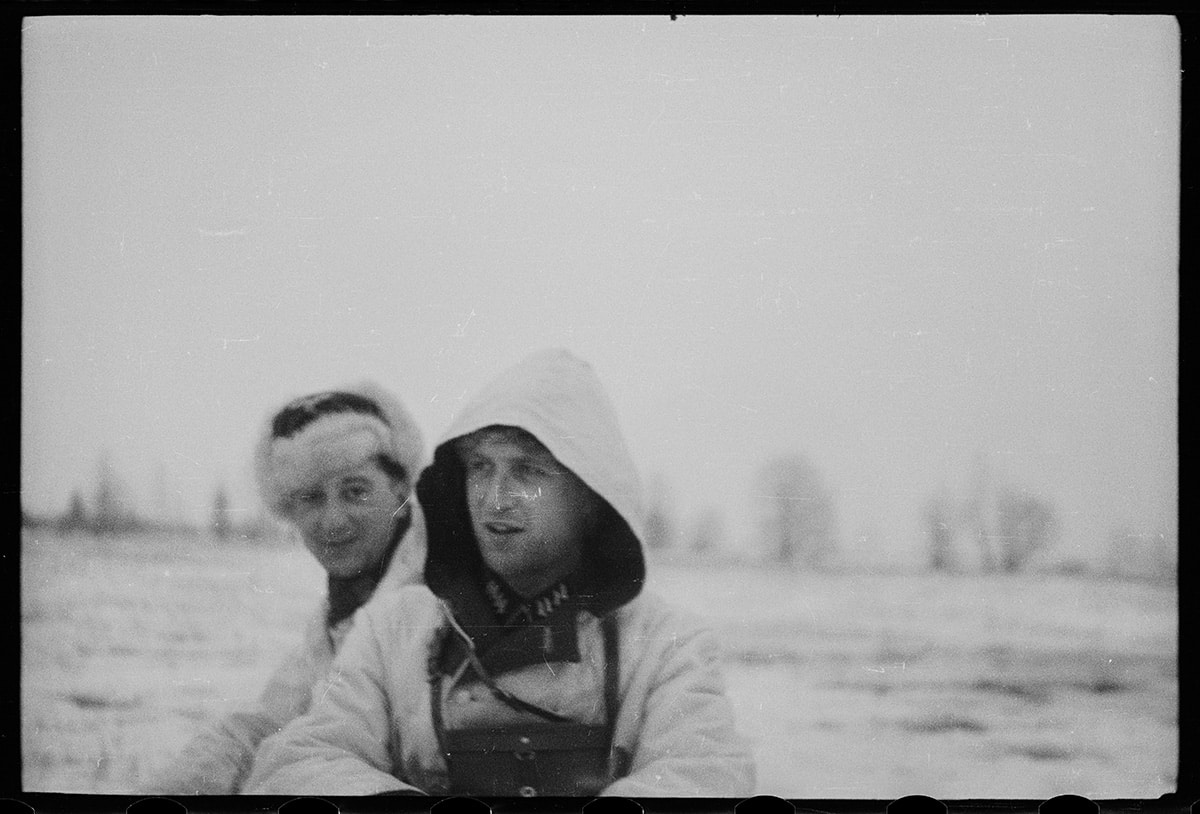
Portrait of a Luftwaffe Oberfeldwebel together with a colleague in winter uniform during a raid on partisans. Vitebsk region, Belarus, USSR. Winter 1941-42
Portrait of a Luftwaffe Oberfeldwebel together with a colleague in winter uniform during a raid on partisans. Vitebsk region, Belarus, USSR. Winter 1941-42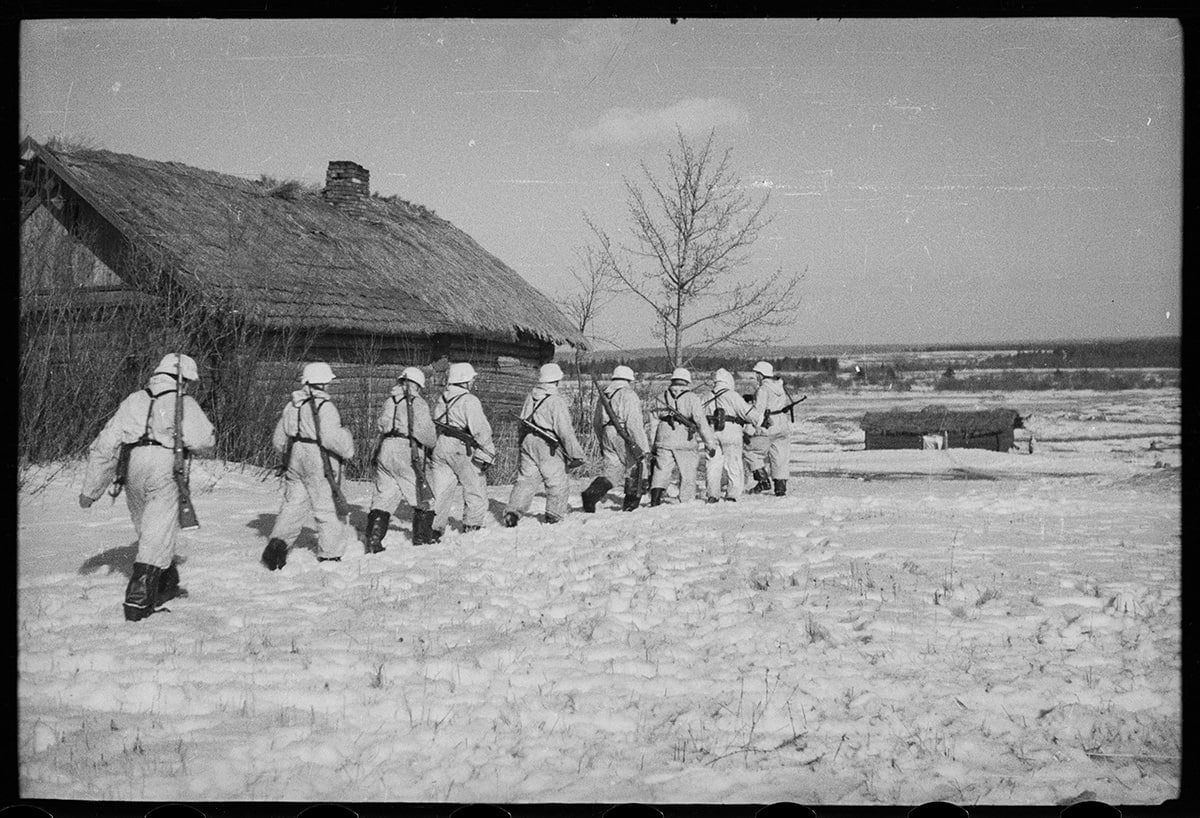
German paratroopers in winter uniform returning from an raid on partisans from one of the occupied villages to the unit's location. Vitebsk region, Belarus, USSR. Winter 1941-42.
German paratroopers in winter uniform returning from an raid on partisans from one of the occupied villages to the unit's location. Vitebsk region, Belarus, USSR. Winter 1941-42.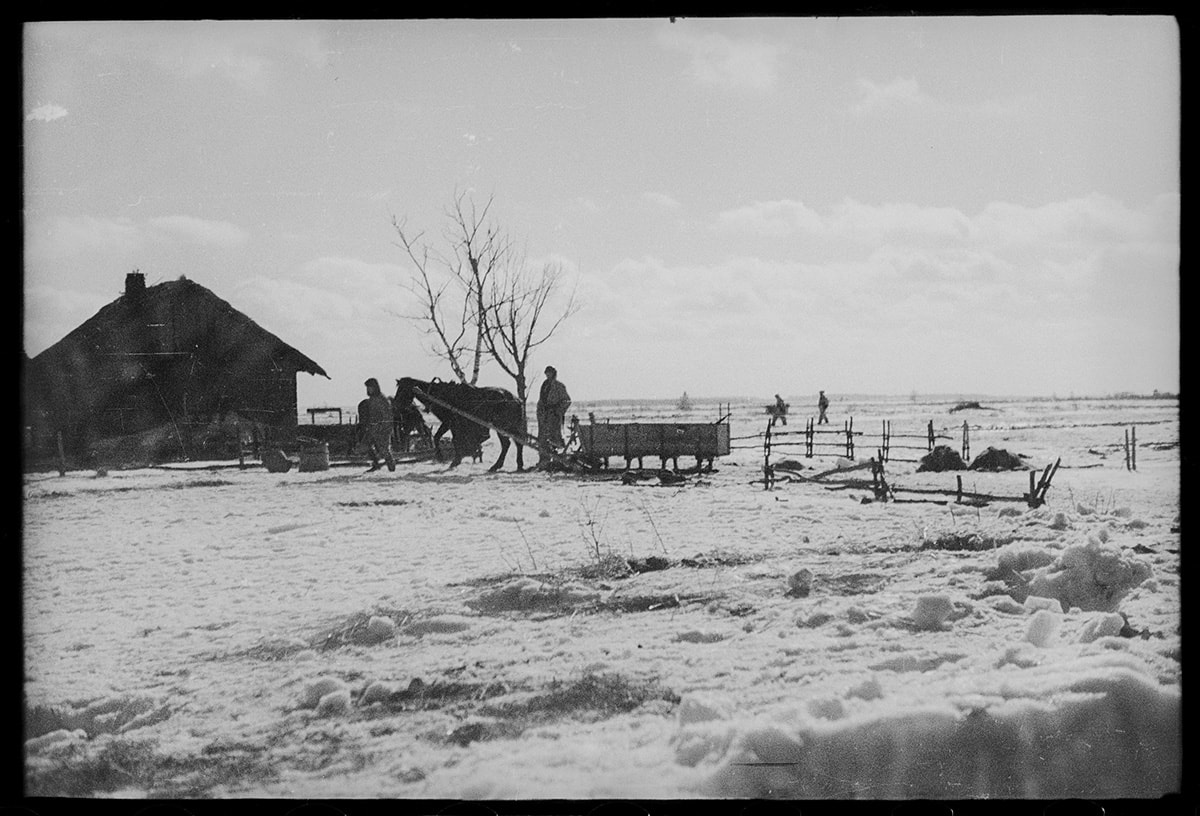
German soldiers in an occupied village. Vitebsk region, Belarus, USSR. Winter 1941-42
German soldiers in an occupied village. Vitebsk region, Belarus, USSR. Winter 1941-42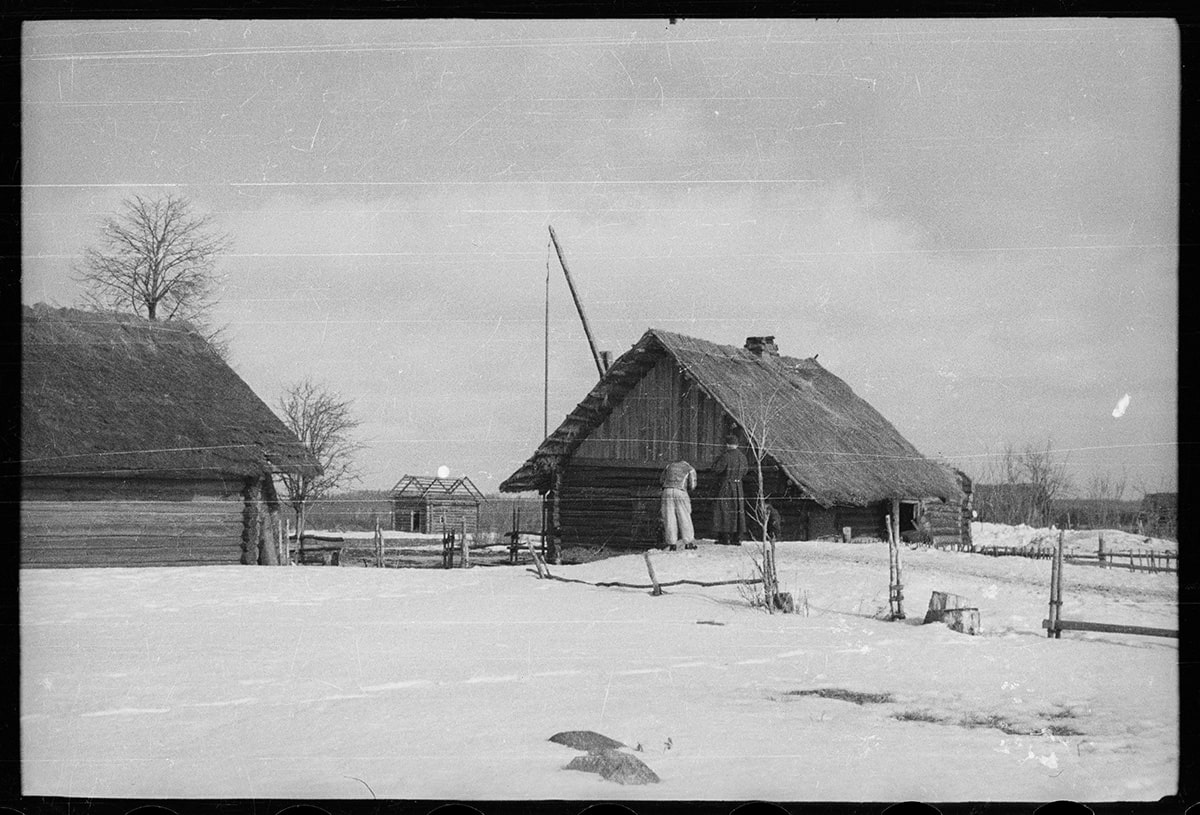
German soldiers in an occupied village. Vitebsk region, Belarus, USSR. Winter 1941-42
German soldiers in an occupied village. Vitebsk region, Belarus, USSR. Winter 1941-42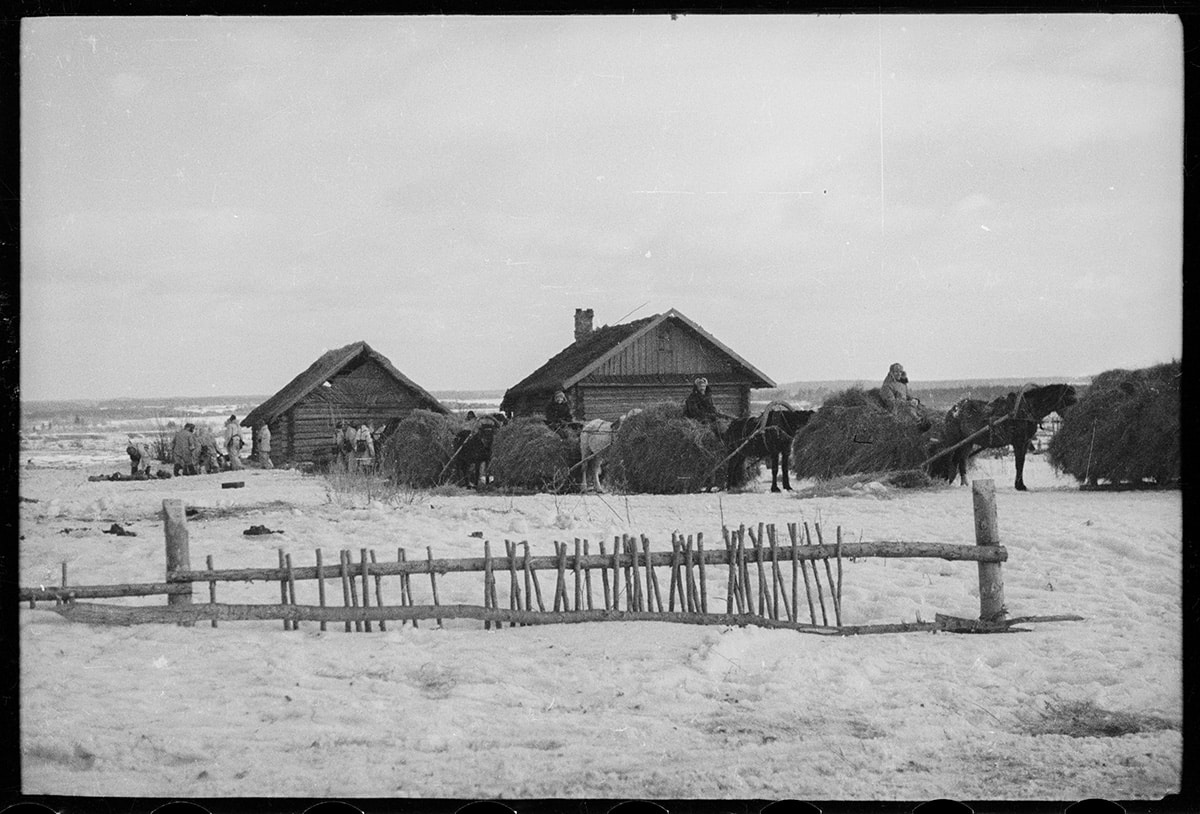
German soldiers dismantle thatched roofs of village houses in an occupied village. Vitebsk region, Belarus, USSR. Winter 1941-42
German soldiers dismantle thatched roofs of village houses in an occupied village. Vitebsk region, Belarus, USSR. Winter 1941-42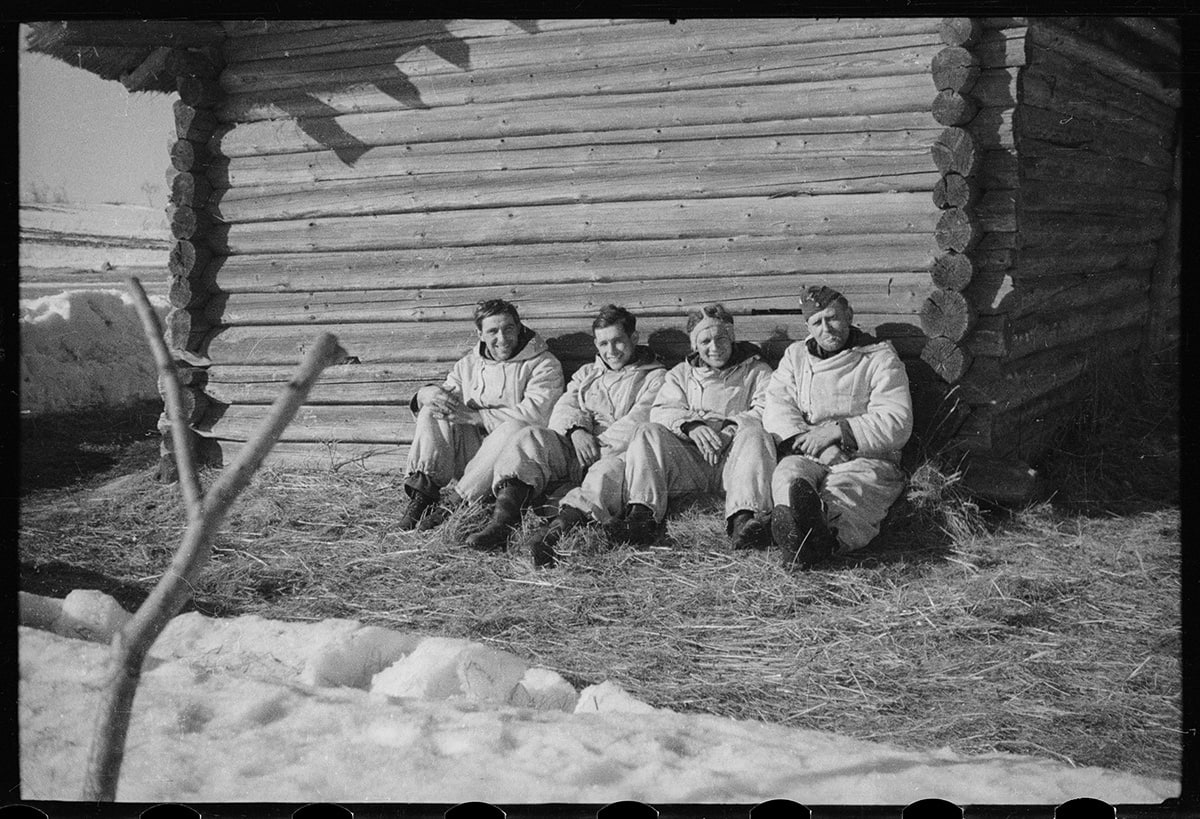
German paratroopers in winter uniforms bask in the sun during a raid on partisans. Vitebsk region, Belarus, USSR. Winter 1941-42
German paratroopers in winter uniforms bask in the sun during a raid on partisans. Vitebsk region, Belarus, USSR. Winter 1941-42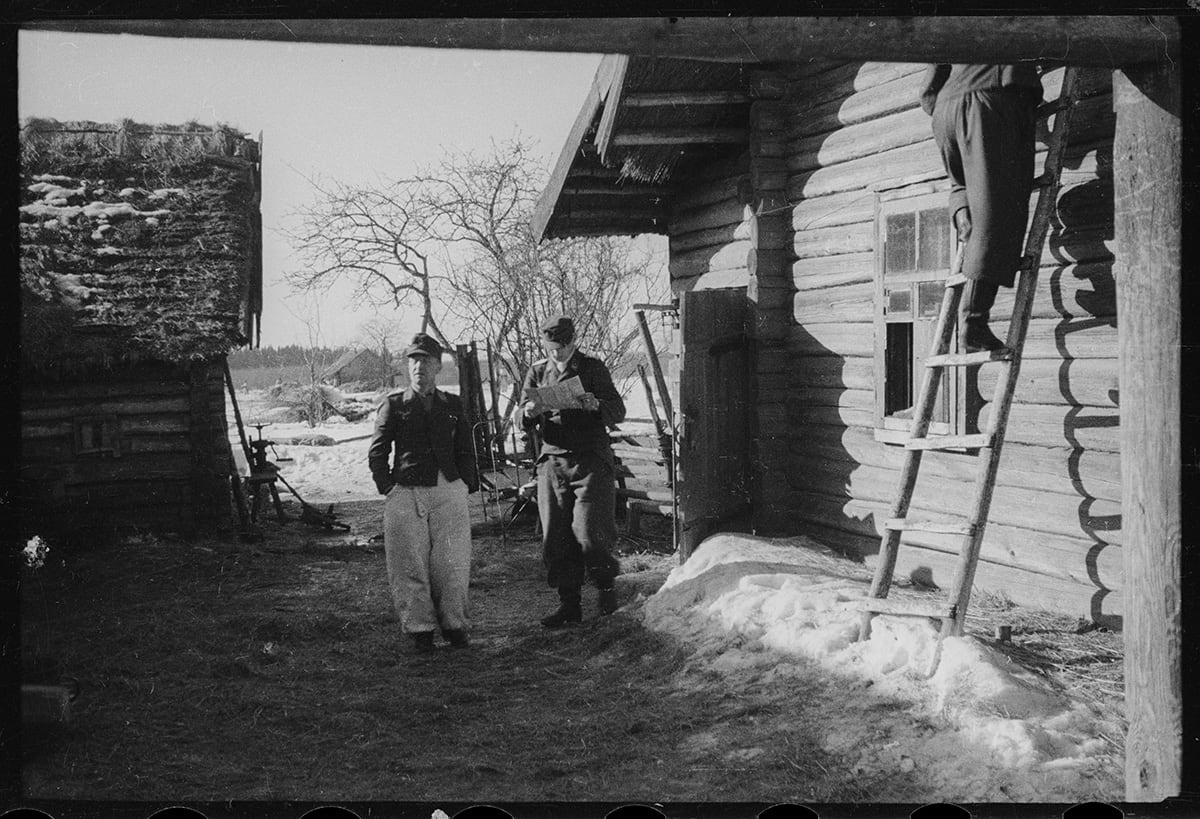
Germans checking village houses during a raid on partisans. On the right, a German soldier checks the attic of a house where partisans could hide. Vitebsk region, Belarus, USSR. Winter 1941-42
Germans checking village houses during a raid on partisans. On the right, a German soldier checks the attic of a house where partisans could hide. Vitebsk region, Belarus, USSR. Winter 1941-42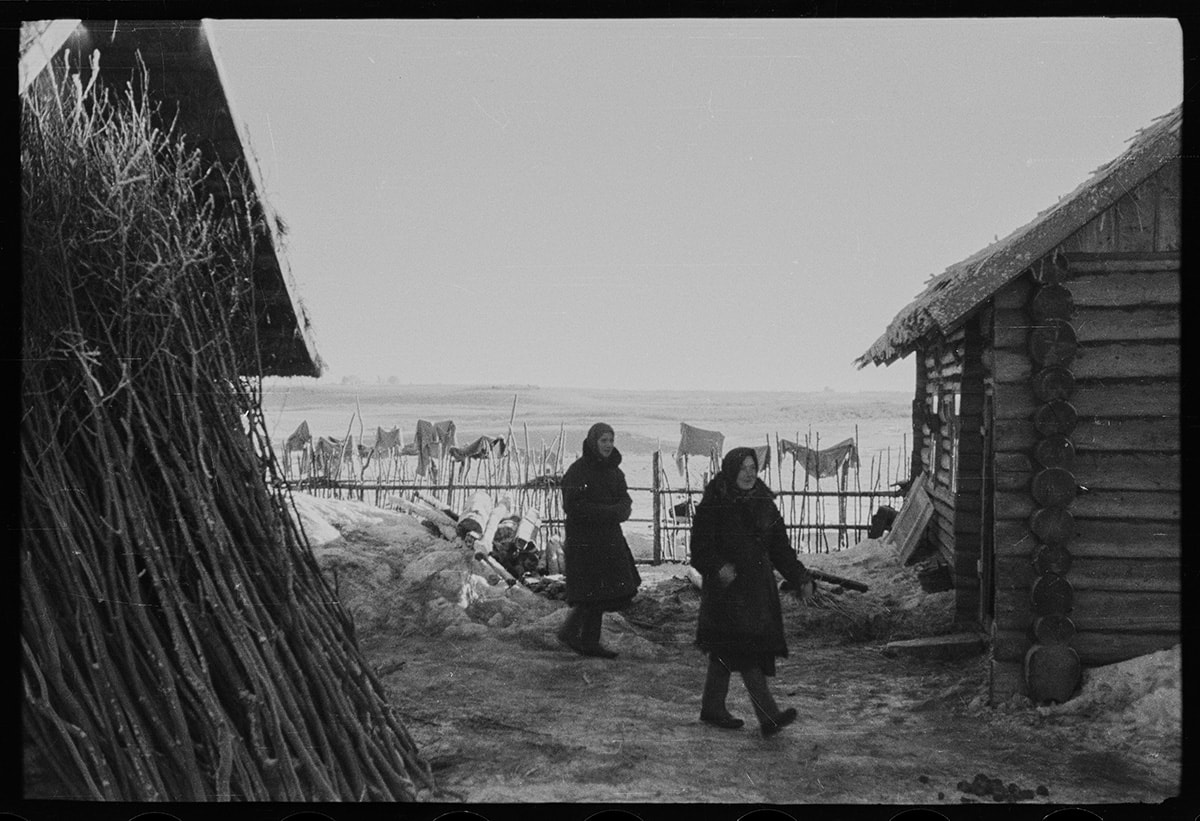
Local residents in one of the occupied villages. Soldiers' clothes, which apparently had to be washed by local women, are drying on the fence. Vitebsk region, Belarus, USSR. Winter 1941-42
Local residents in one of the occupied villages. Soldiers' clothes, which apparently had to be washed by local women, are drying on the fence. Vitebsk region, Belarus, USSR. Winter 1941-42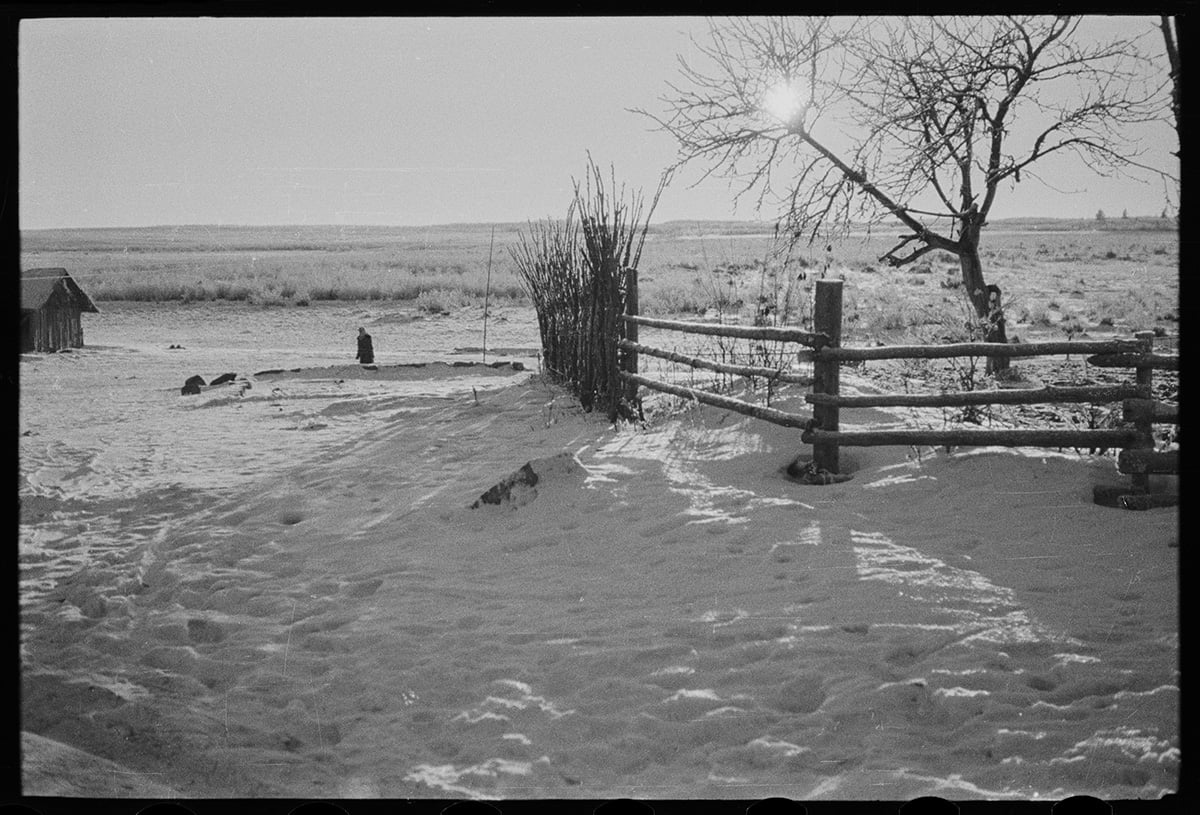
A local resident in one of the occupied villages. Vitebsk region, Belarus, USSR. Winter 1941-42
A local resident in one of the occupied villages. Vitebsk region, Belarus, USSR. Winter 1941-42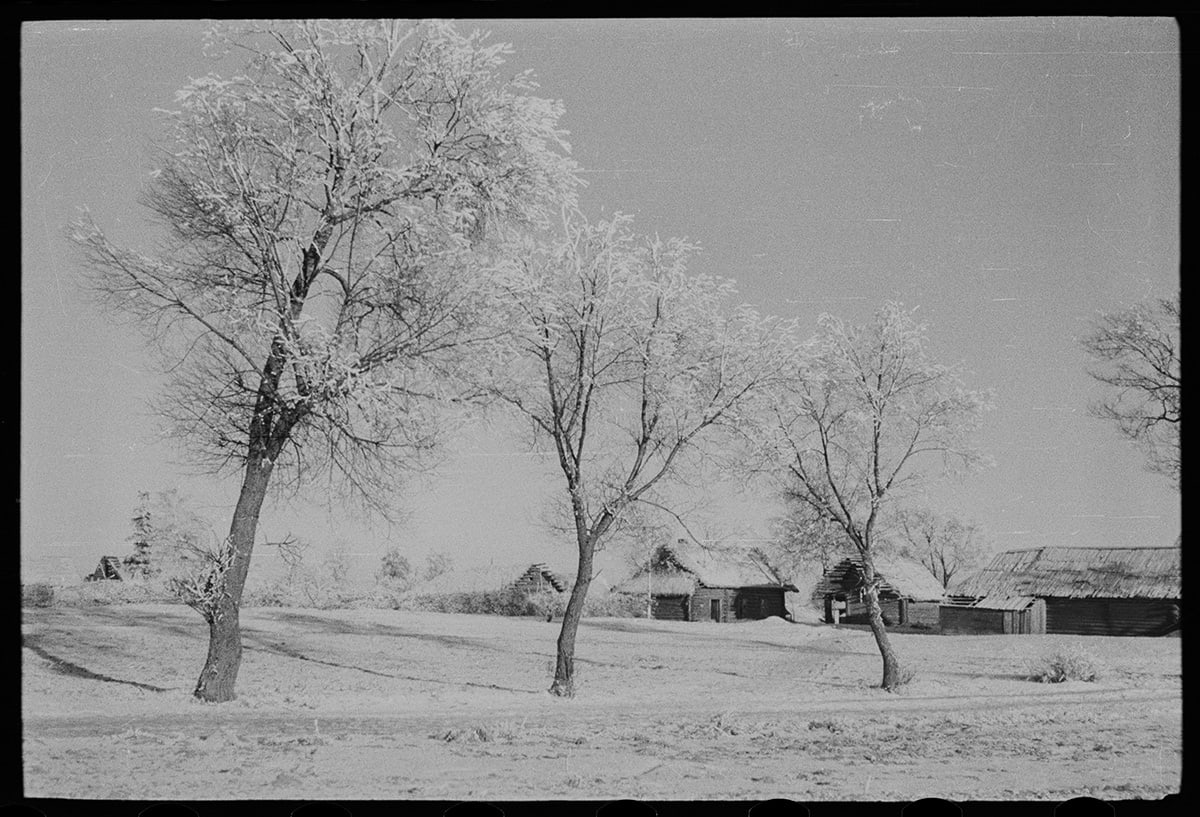
Landscape of one of the occupied villages. Judging by the frozen branches on the trees, there was an unusually severe frost for Germans. Vitebsk region, Belarus, USSR. Winter 1941-42
Landscape of one of the occupied villages. Judging by the frozen branches on the trees, there was an unusually severe frost for Germans. Vitebsk region, Belarus, USSR. Winter 1941-42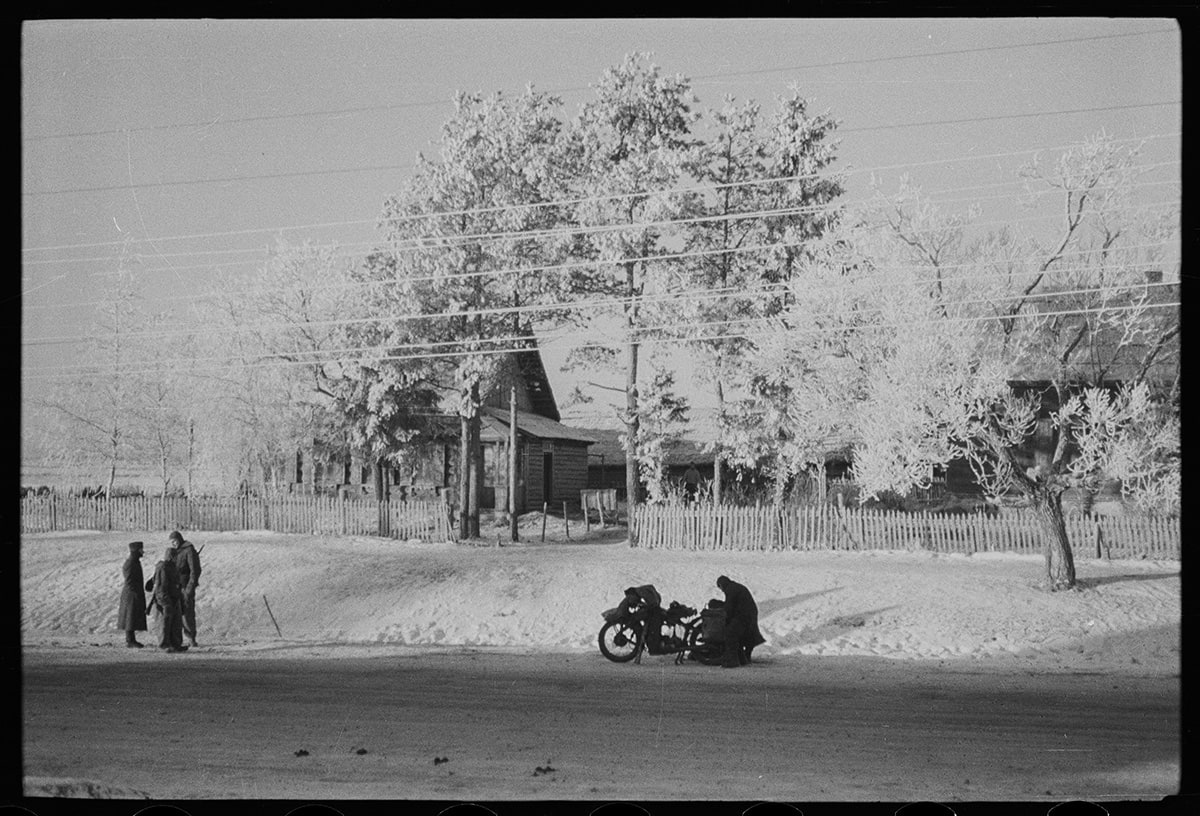
The main street of one of the occupied villages. On the outskirts of the road the military are repairing a German motorcycle. Vitebsk region, Belarus, USSR. Winter 1941-42
The main street of one of the occupied villages. On the outskirts of the road the military are repairing a German motorcycle. Vitebsk region, Belarus, USSR. Winter 1941-42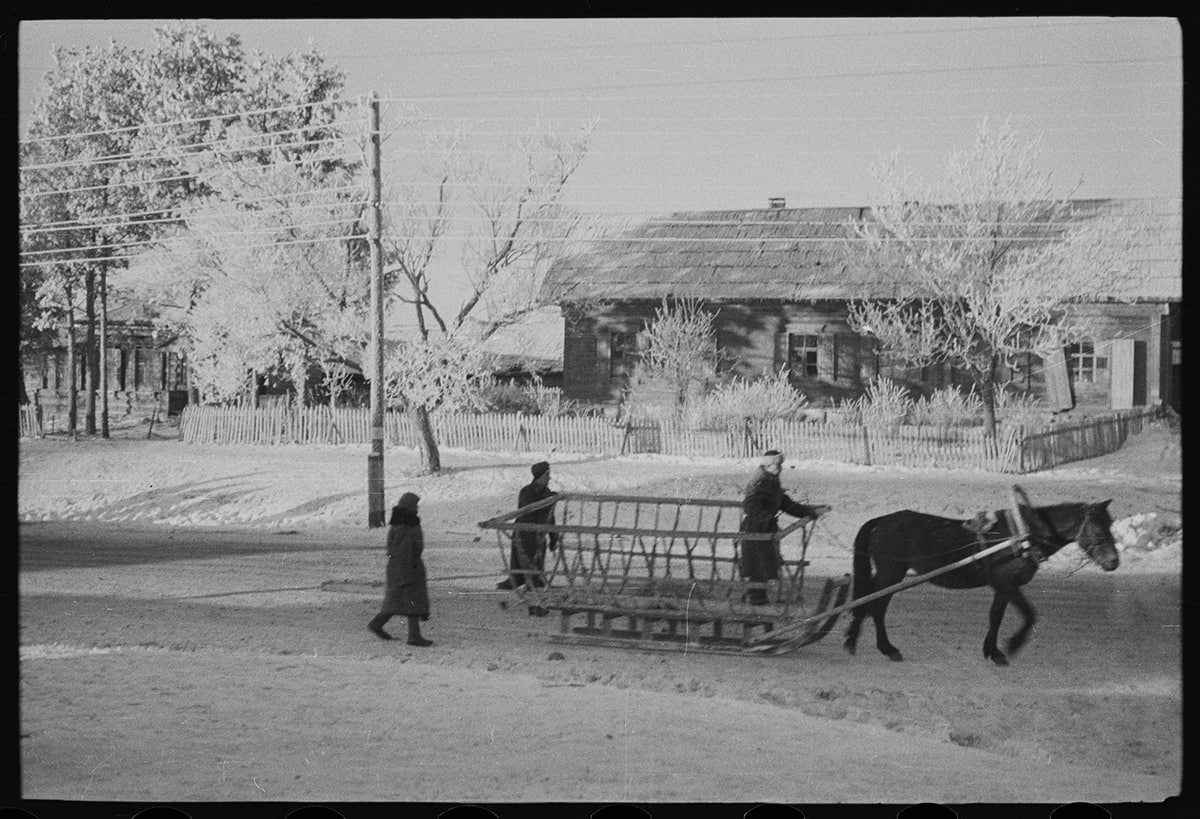
A horse-drawn sleigh on the main street of an occupied village. Vitebsk region, Belarus, USSR. Winter 1941-42
A horse-drawn sleigh on the main street of an occupied village. Vitebsk region, Belarus, USSR. Winter 1941-42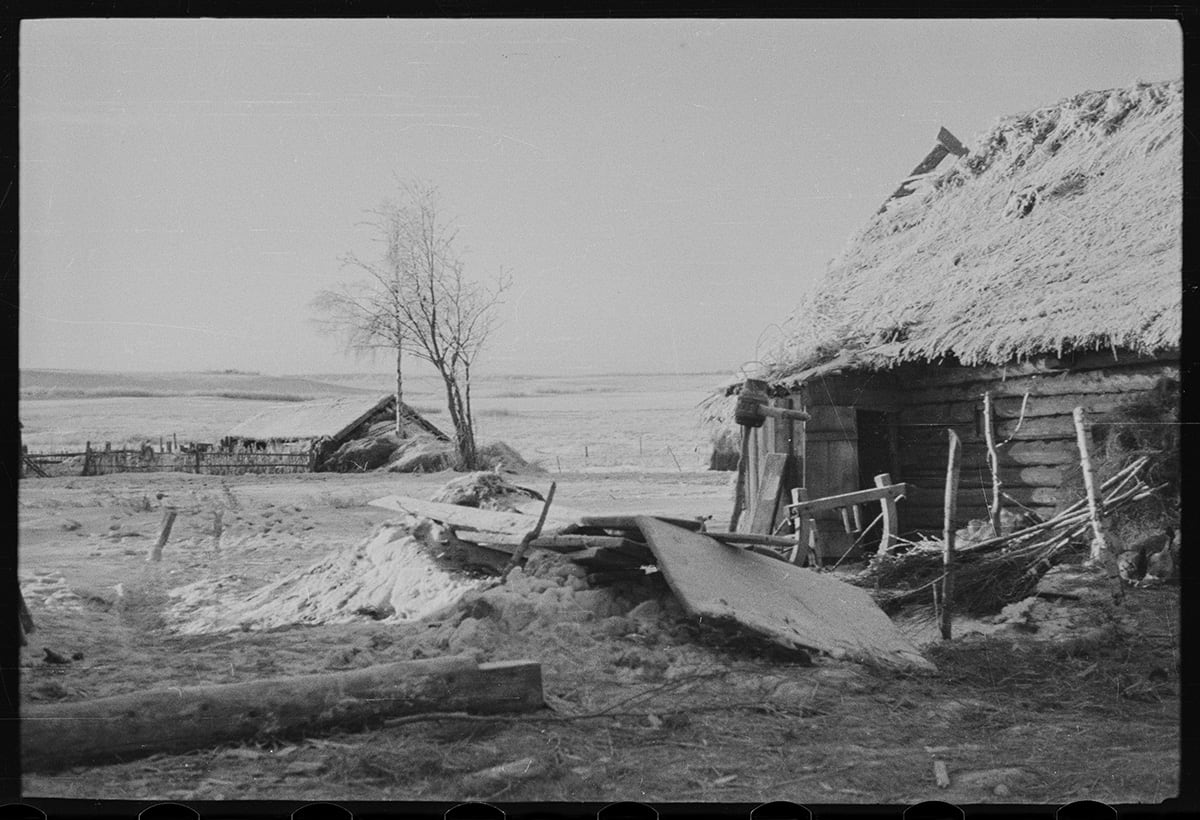
Planks and logs near one of the demolished village houses. Vitebsk region, Belarus, USSR. Winter 1941-42
Planks and logs near one of the demolished village houses. Vitebsk region, Belarus, USSR. Winter 1941-42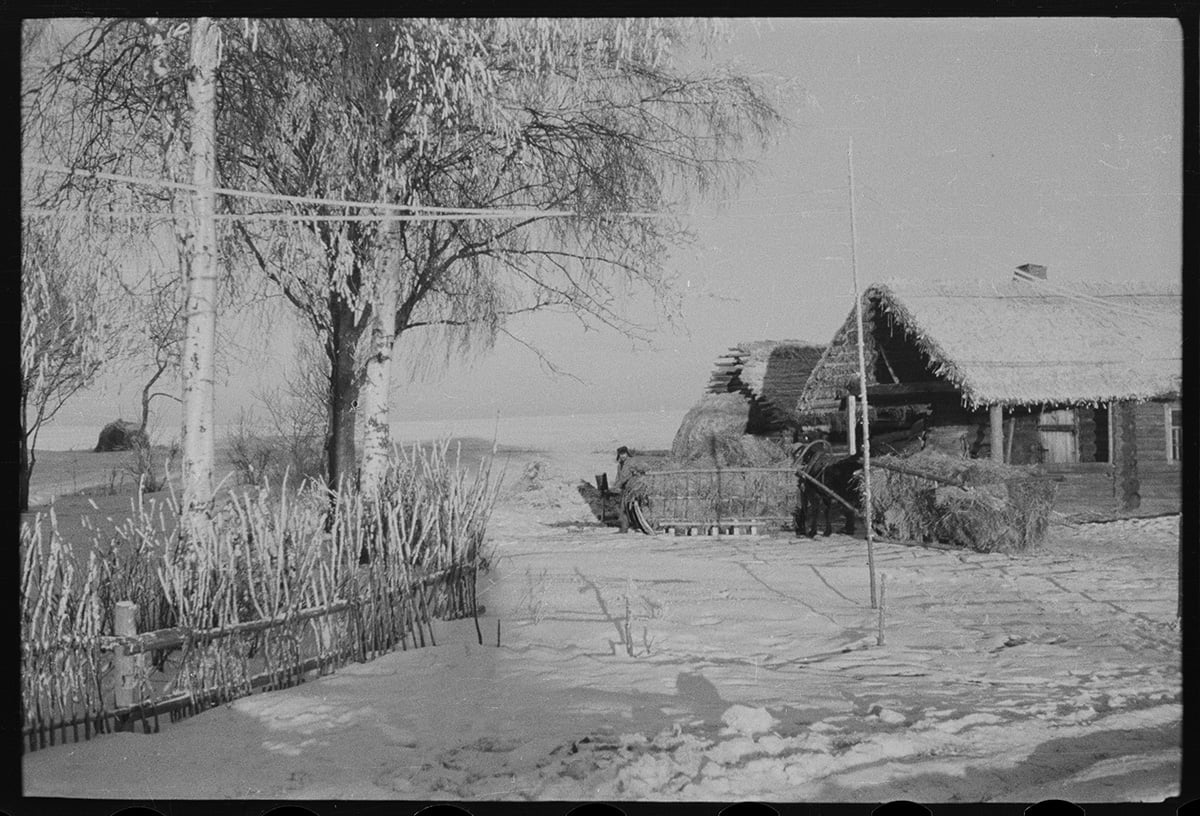
A horse-drawn sleigh full of hay near the German headquarters in an occupied village. Vitebsk region, Belarus, USSR. Winter 1941-42
A horse-drawn sleigh full of hay near the German headquarters in an occupied village. Vitebsk region, Belarus, USSR. Winter 1941-42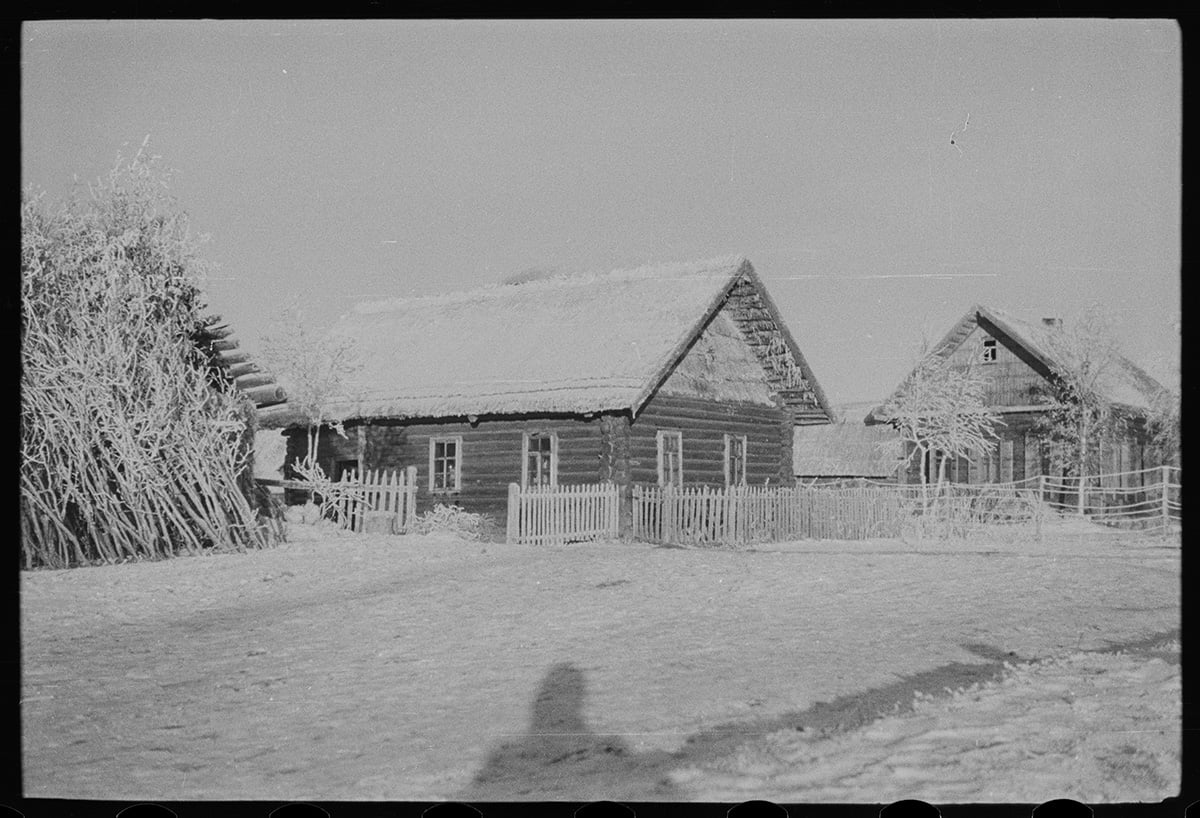
Houses where Germans lived in one of the occupied villages. A barbed wire fence is visible in the background. Vitebsk region, Belarus, USSR. Winter 1941-42
Houses where Germans lived in one of the occupied villages. A barbed wire fence is visible in the background. Vitebsk region, Belarus, USSR. Winter 1941-42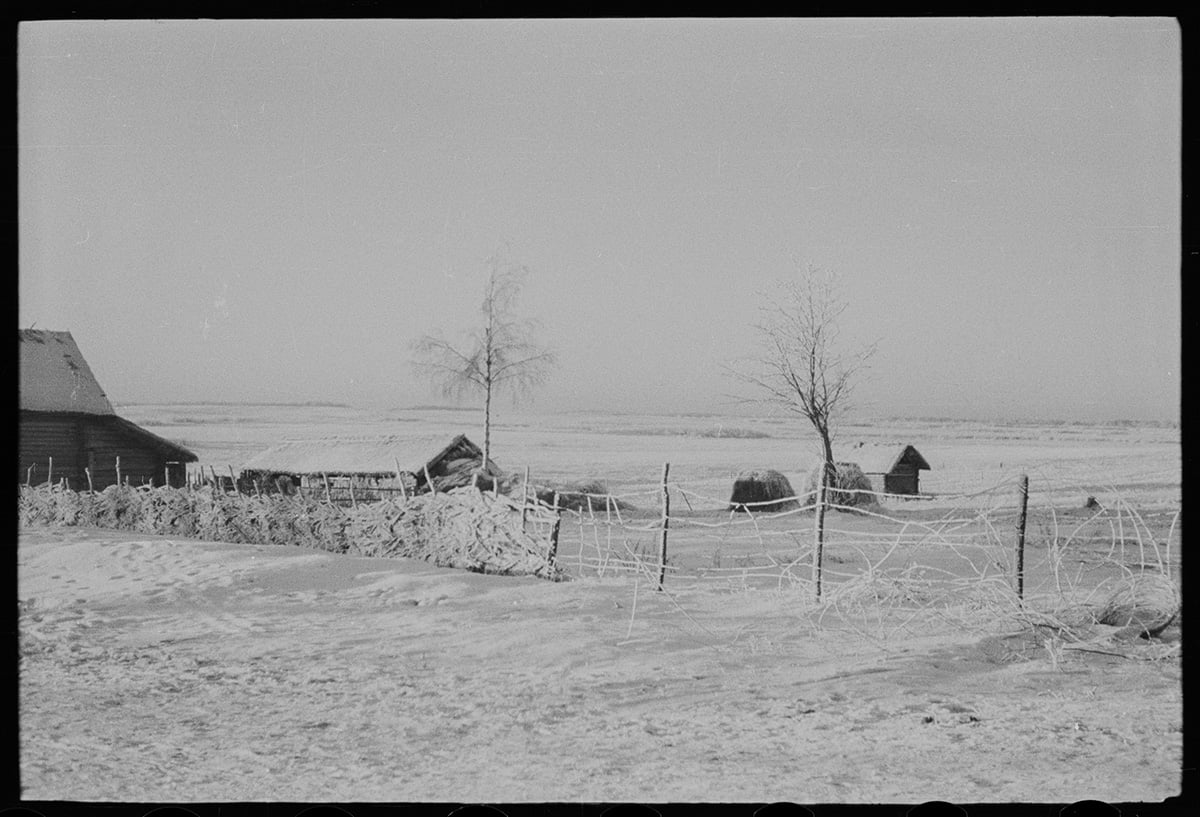
Barbed wire fence around the perimeter of houses and the part where the German military were based. Vitebsk region, Belarus, USSR. Winter 1941-42
Barbed wire fence around the perimeter of houses and the part where the German military were based. Vitebsk region, Belarus, USSR. Winter 1941-42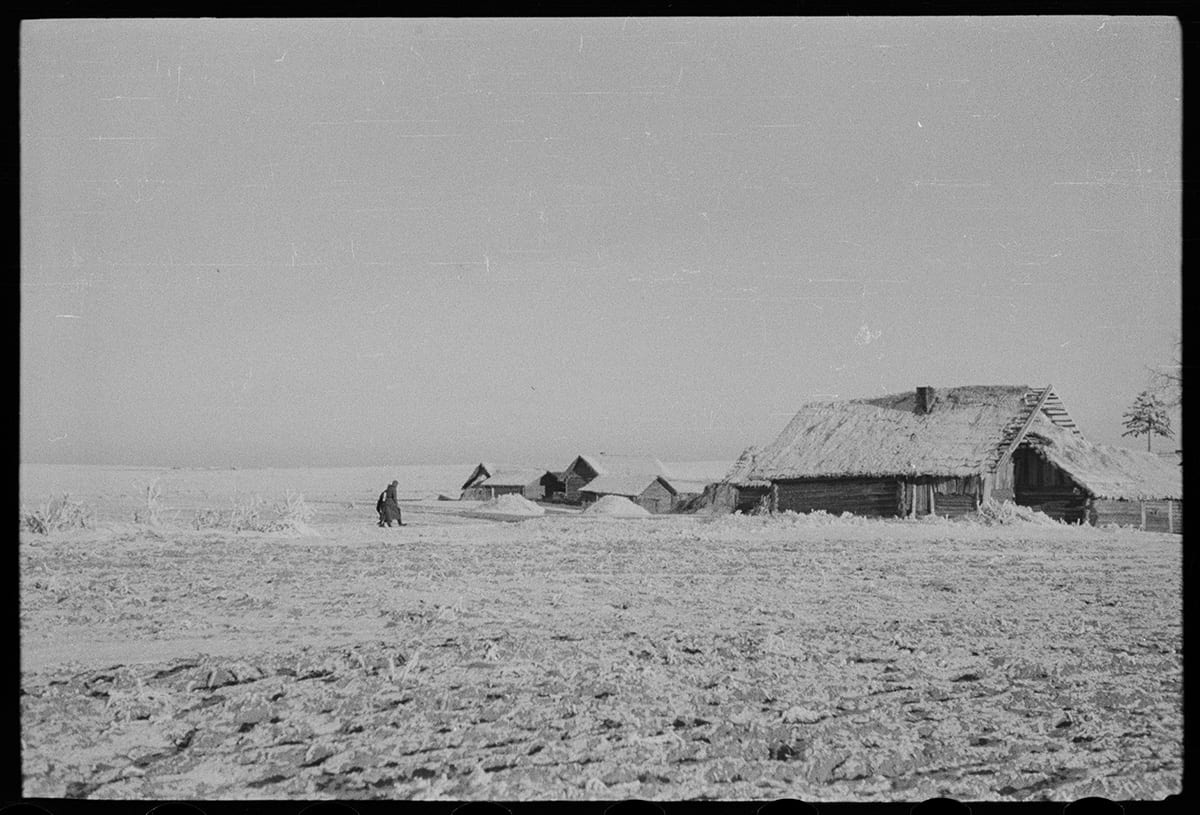
Panorama of one of the German-occupied villages during severe frosts. Vitebsk region, Belarus, USSR. Winter 1941-42
Panorama of one of the German-occupied villages during severe frosts. Vitebsk region, Belarus, USSR. Winter 1941-42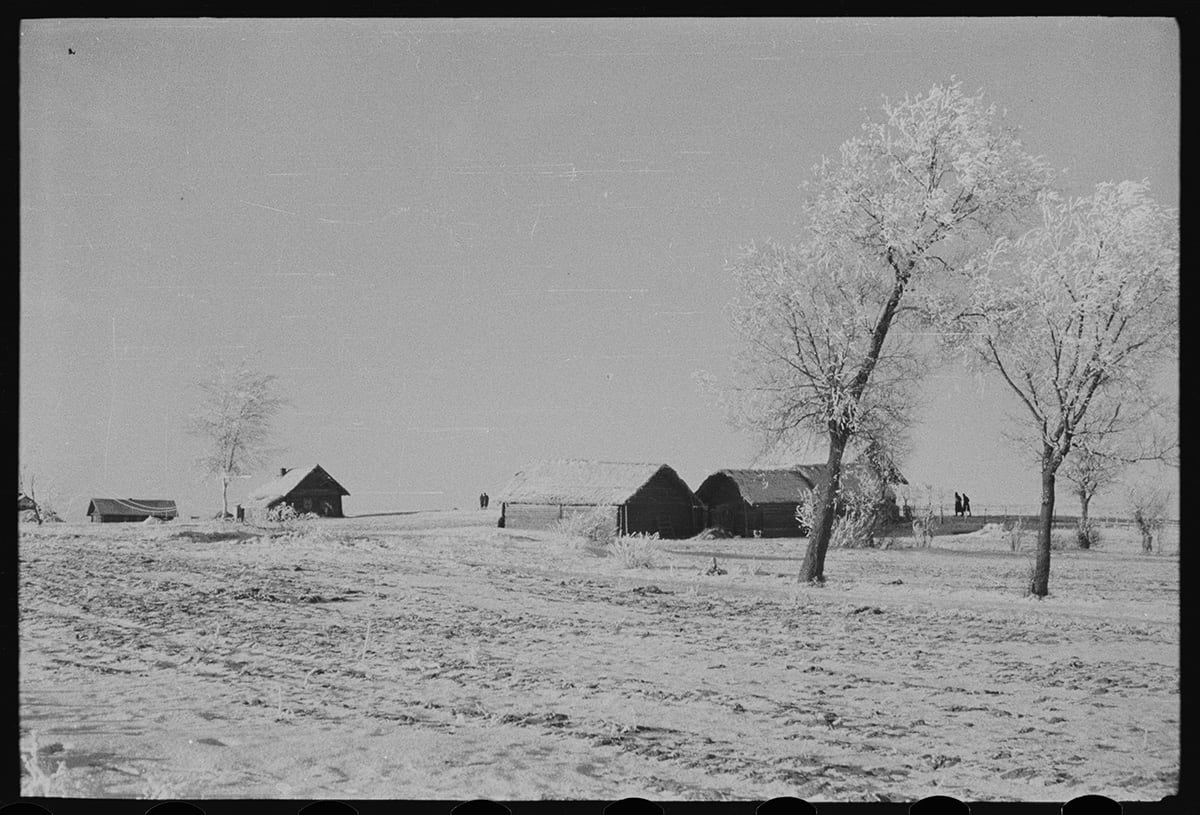
Panorama of one of the German-occupied villages during severe frosts. Vitebsk region, Belarus, USSR. Winter 1941-42
Panorama of one of the German-occupied villages during severe frosts. Vitebsk region, Belarus, USSR. Winter 1941-42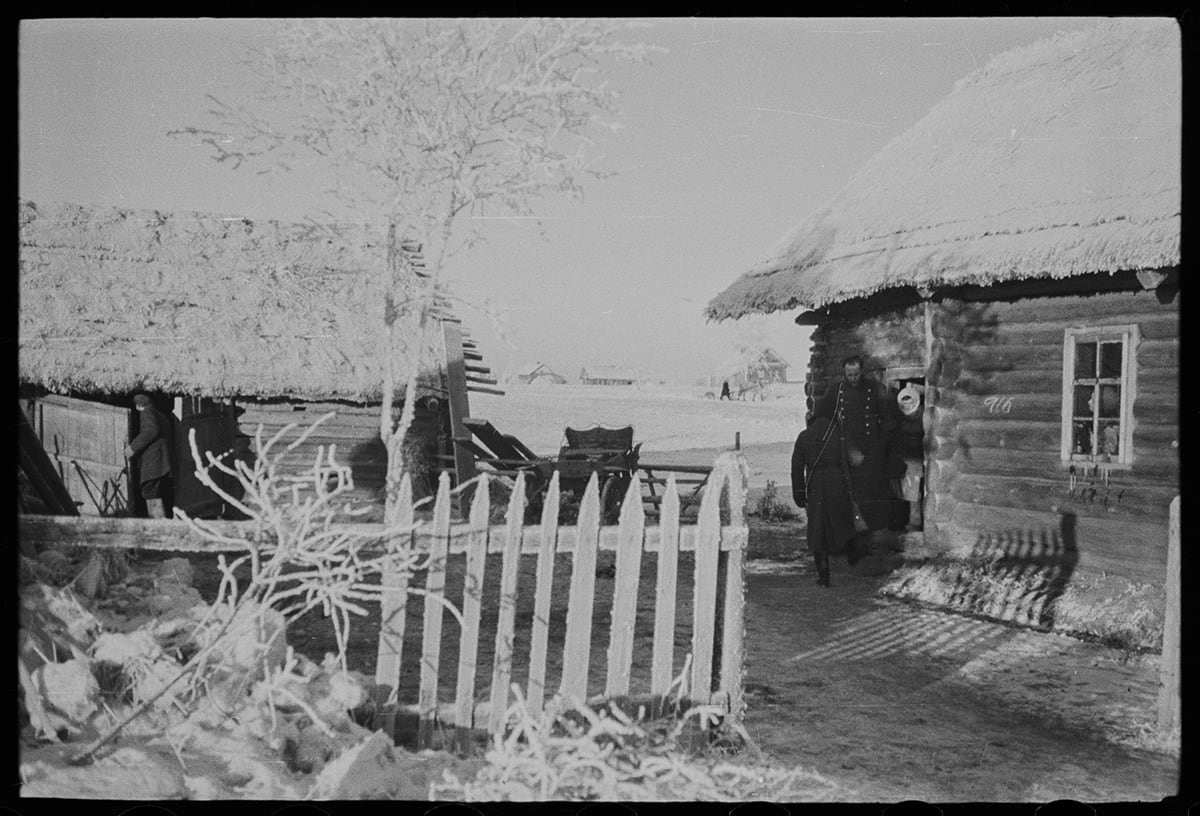
Germans check houses in one of the occupied villages during severe frosts. Vitebsk region, Belarus, USSR. Winter 1941-42
Germans check houses in one of the occupied villages during severe frosts. Vitebsk region, Belarus, USSR. Winter 1941-42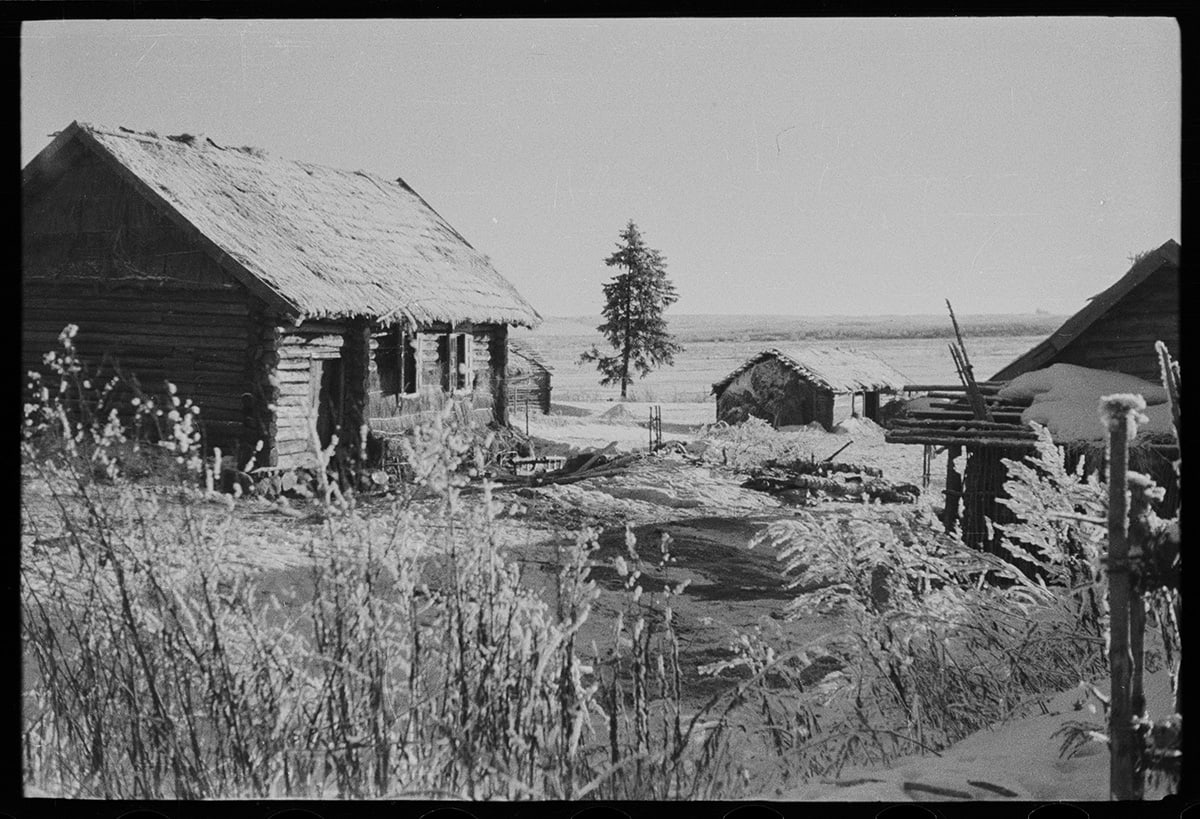
Landscape with village houses in one of the German-occupied villages during severe frosts. Vitebsk region, Belarus, USSR. Winter 1941-42
Landscape with village houses in one of the German-occupied villages during severe frosts. Vitebsk region, Belarus, USSR. Winter 1941-42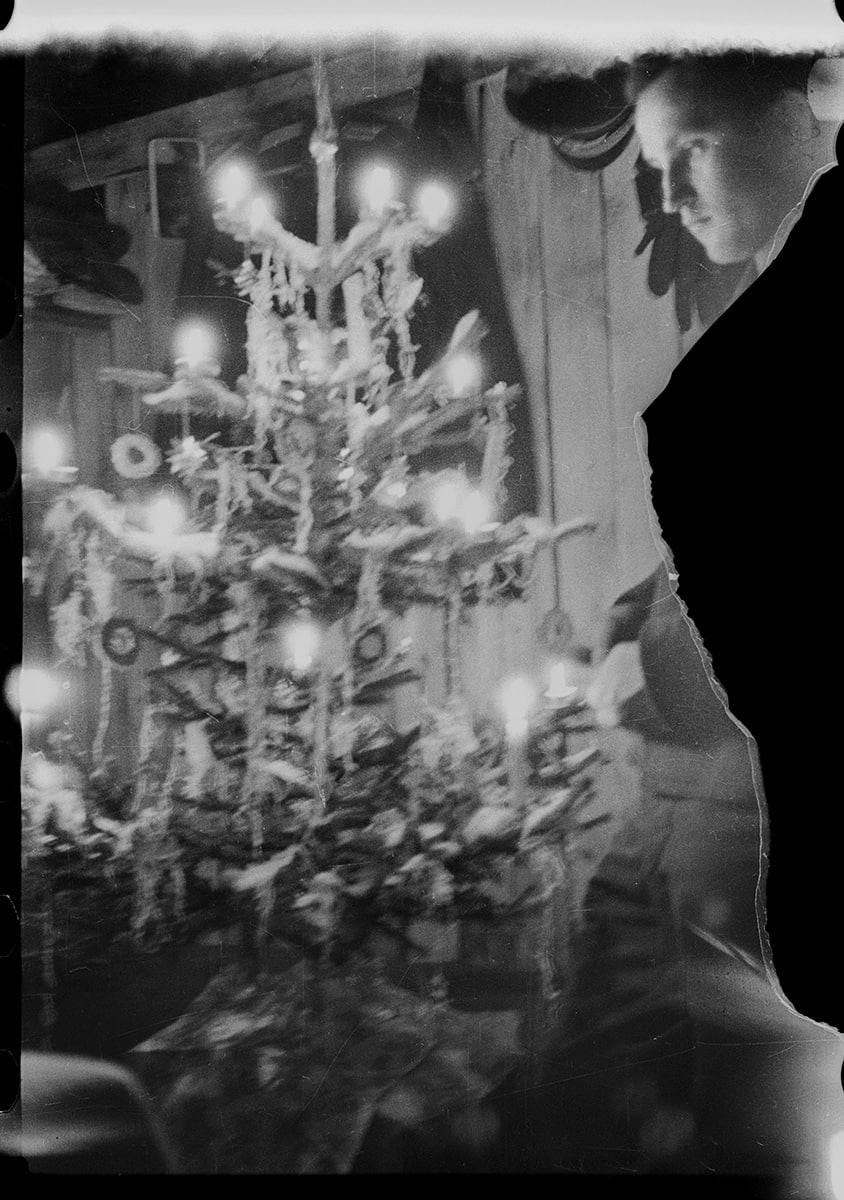
A German soldier standing near a Christmas tree with candles at the German headquarters. Vitebsk region, Belarus, USSR. Winter 1941-42
A German soldier standing near a Christmas tree with candles at the German headquarters. Vitebsk region, Belarus, USSR. Winter 1941-42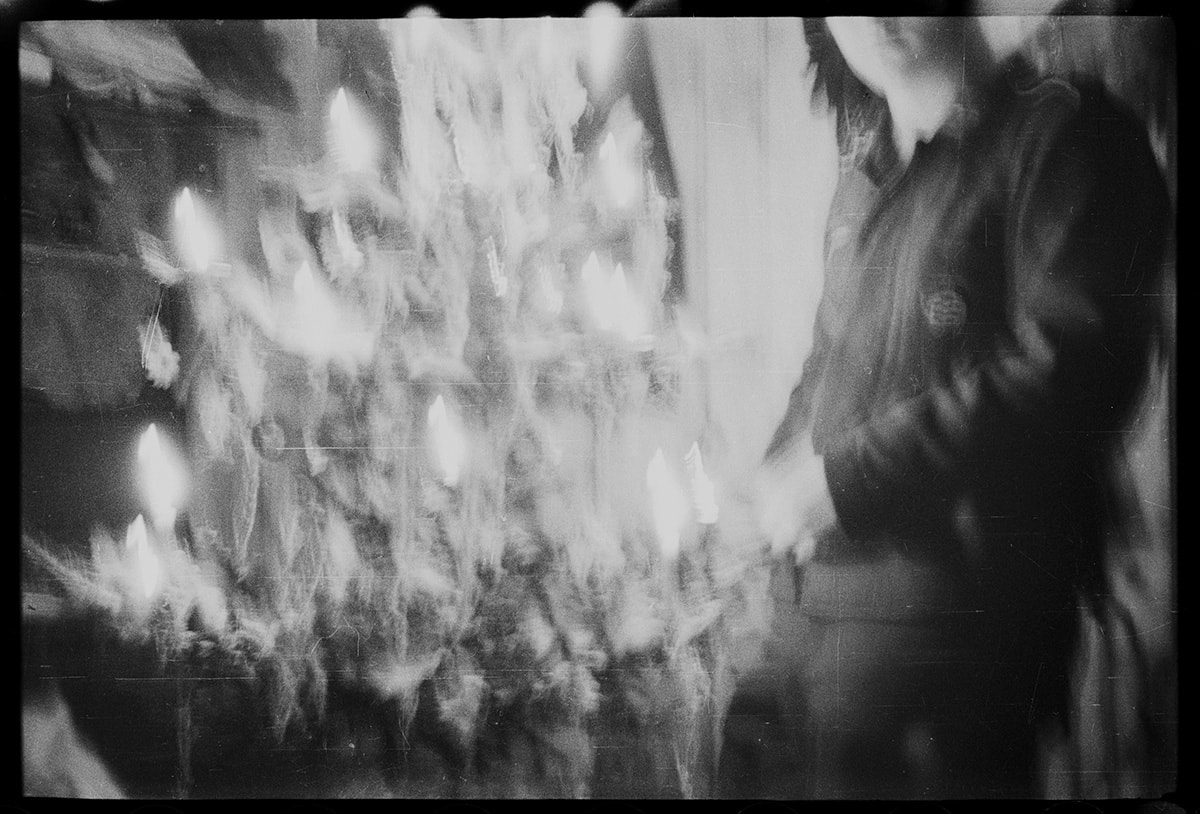
A German soldier standing near a Christmas tree with candles at the German headquarters. Vitebsk region, Belarus, USSR. Winter 1941-42
A German soldier standing near a Christmas tree with candles at the German headquarters. Vitebsk region, Belarus, USSR. Winter 1941-42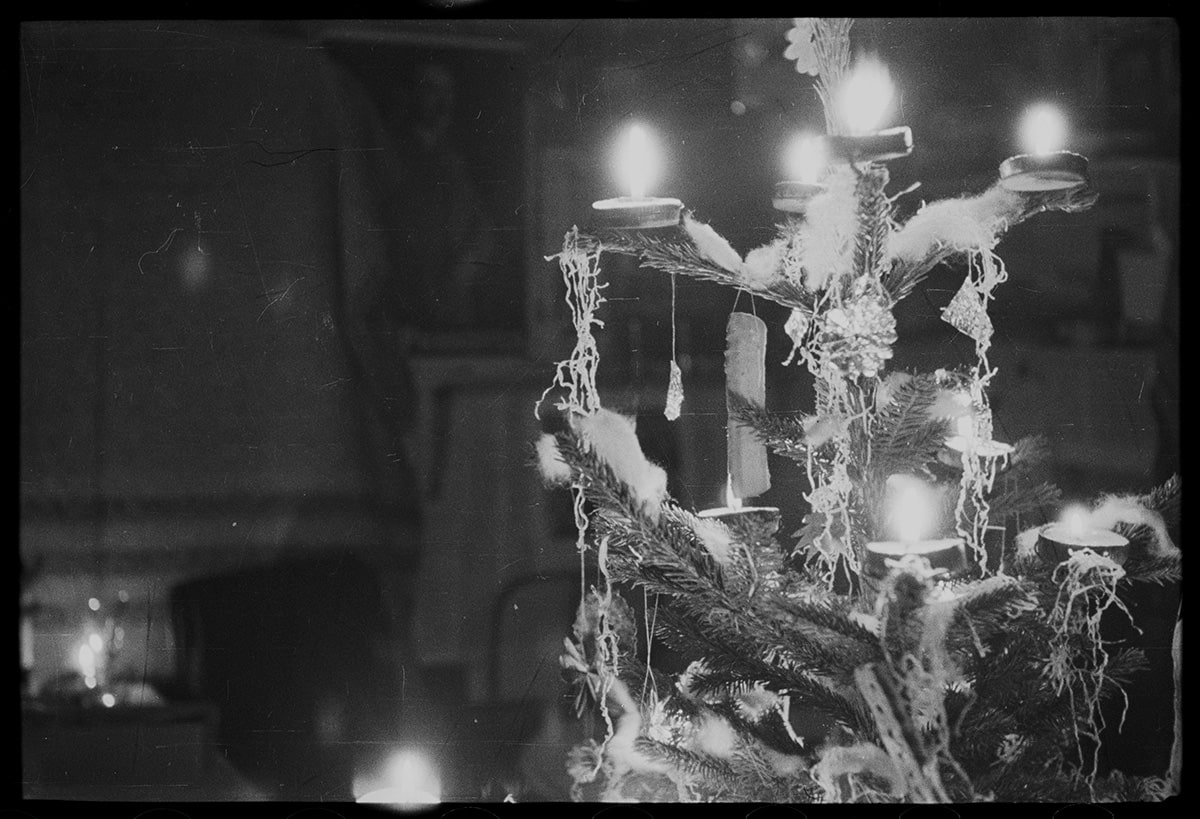
Christmas tree with candles in a German headquarters. A poster with the image of Hitler and the inscription "Hitler is a liberator!" is seen in the background. Vitebsk region, Belarus, USSR. Winter 1941-42
Christmas tree with candles in a German headquarters. A poster with the image of Hitler and the inscription "Hitler is a liberator!" is seen in the background. Vitebsk region, Belarus, USSR. Winter 1941-42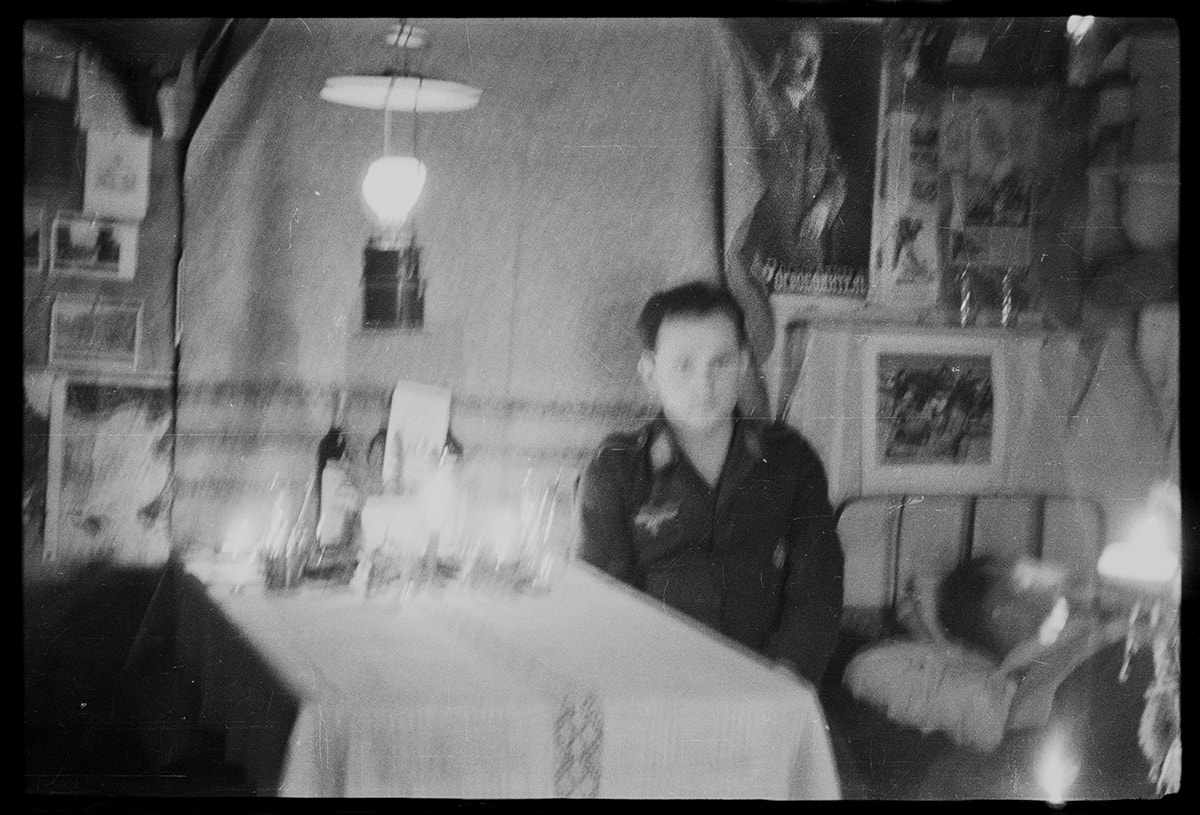
A German military man sits at a table near a Christmas tree with candles in the German headquarters. A poster with the image of Hitler and the inscription "Hitler is a liberator!" is seen on the camp. Vitebsk region, Belarus, USSR. Winter 1941-42
A German military man sits at a table near a Christmas tree with candles in the German headquarters. A poster with the image of Hitler and the inscription "Hitler is a liberator!" is seen on the camp. Vitebsk region, Belarus, USSR. Winter 1941-42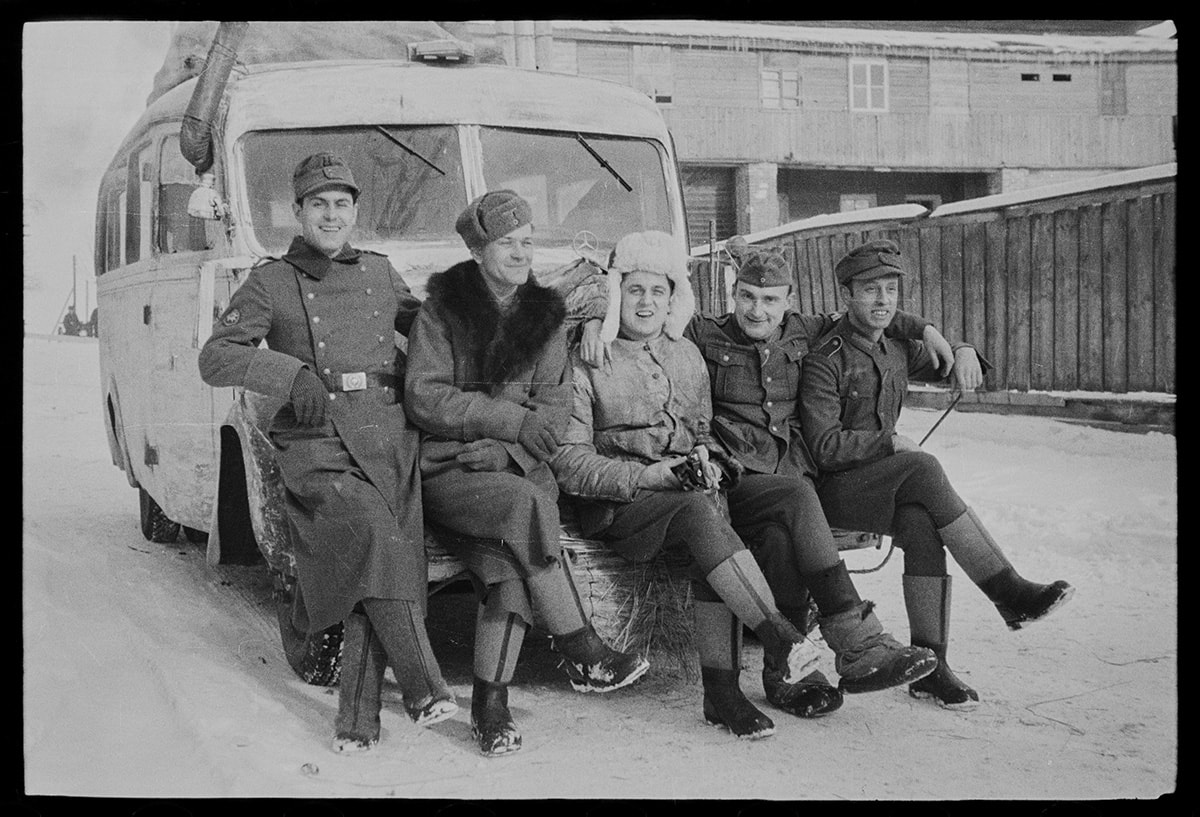
A group portrait of German soldiers and officers on the front bumper of a Mercedes-Benz O 2600 army bus in winter camouflage. The leftmost one is a soldier from the Mountain Infantry Division with the "Edelweiss" patch, in the middle are two Luftwaffe officers in special winter fur hats. Vitebsk region, Belarus, USSR. Winter 1941-42
A group portrait of German soldiers and officers on the front bumper of a Mercedes-Benz O 2600 army bus in winter camouflage. The leftmost one is a soldier from the Mountain Infantry Division with the "Edelweiss" patch, in the middle are two Luftwaffe officers in special winter fur hats. Vitebsk region, Belarus, USSR. Winter 1941-42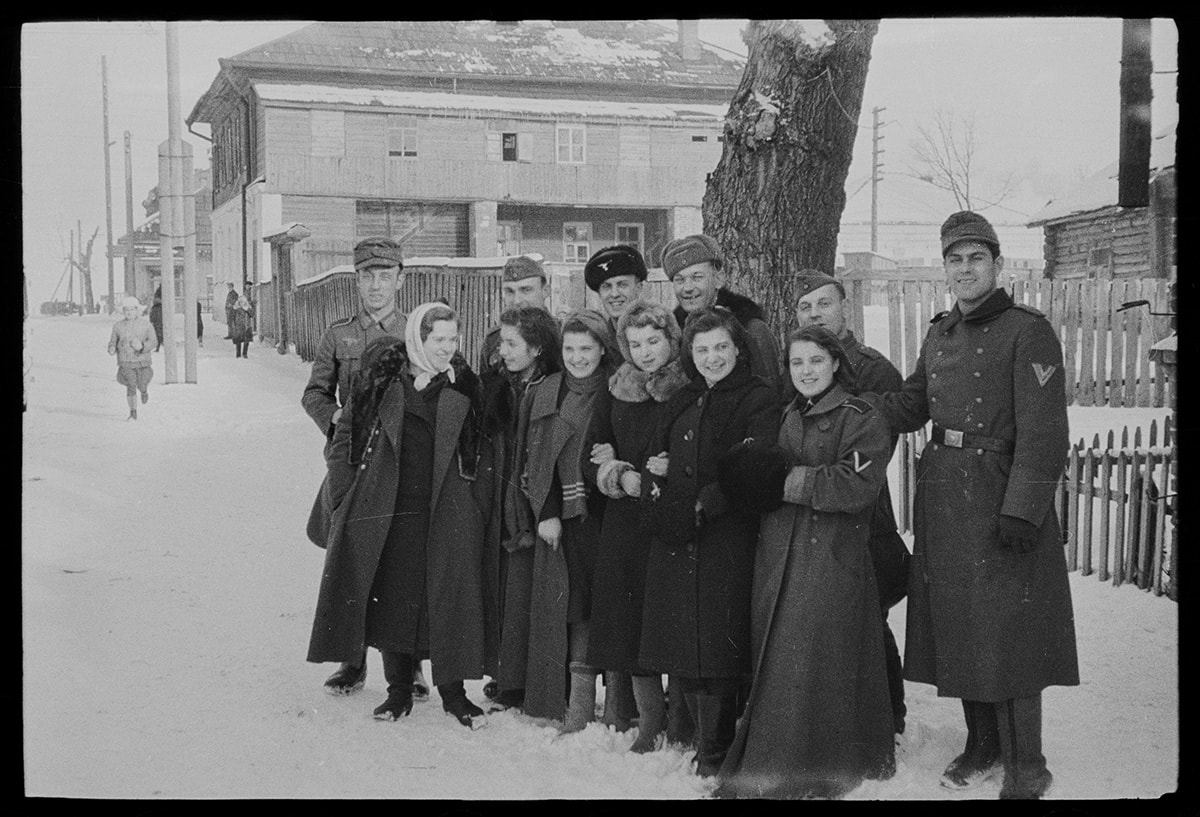
Group portrait of German soldiers and officers together with local girls, some of whom are dressed in German overcoats. Vitebsk region, Belarus, USSR. Winter 1941-42
Group portrait of German soldiers and officers together with local girls, some of whom are dressed in German overcoats. Vitebsk region, Belarus, USSR. Winter 1941-42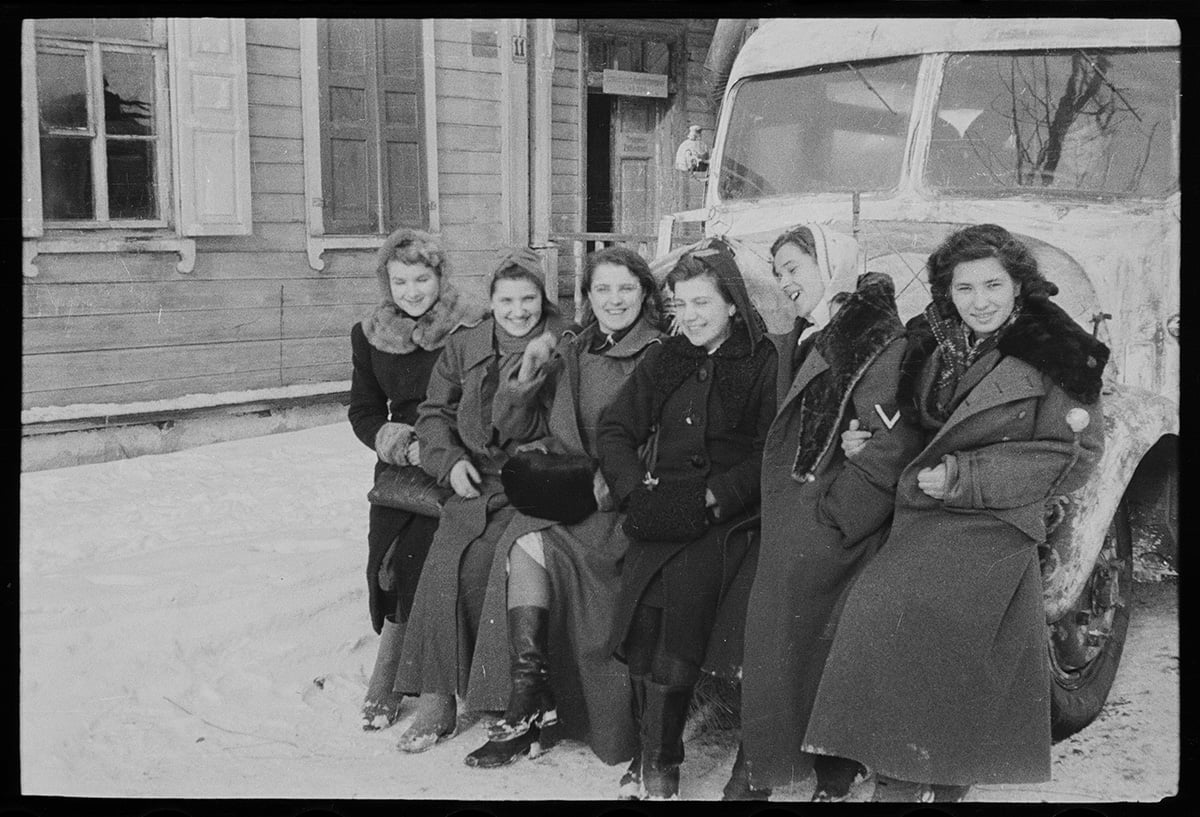
Group portrait of local girls, some of whom are wearing German overcoats, on the front bumper of a Mercedes-Benz O 2600 army bus in winter camouflage. A German military man smiling at the wheel. Vitebsk region, Belarus, USSR. Winter 1941-42
Group portrait of local girls, some of whom are wearing German overcoats, on the front bumper of a Mercedes-Benz O 2600 army bus in winter camouflage. A German military man smiling at the wheel. Vitebsk region, Belarus, USSR. Winter 1941-42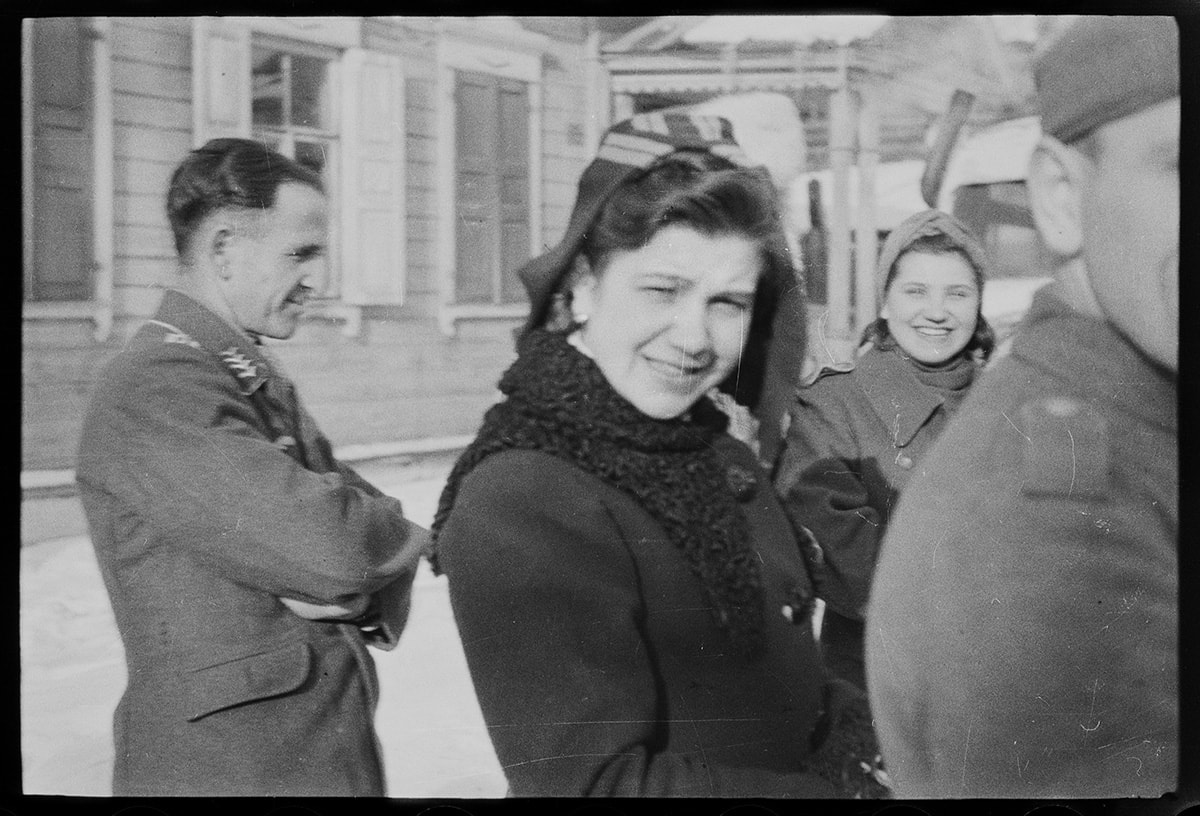
Portrait of German soldiers with local girls. The girl in the foreground is dressed in a black coat with a scribble collar, and in the background - in a German overcoat. Vitebsk region, Belarus, USSR. Winter 1941-42
Portrait of German soldiers with local girls. The girl in the foreground is dressed in a black coat with a scribble collar, and in the background - in a German overcoat. Vitebsk region, Belarus, USSR. Winter 1941-42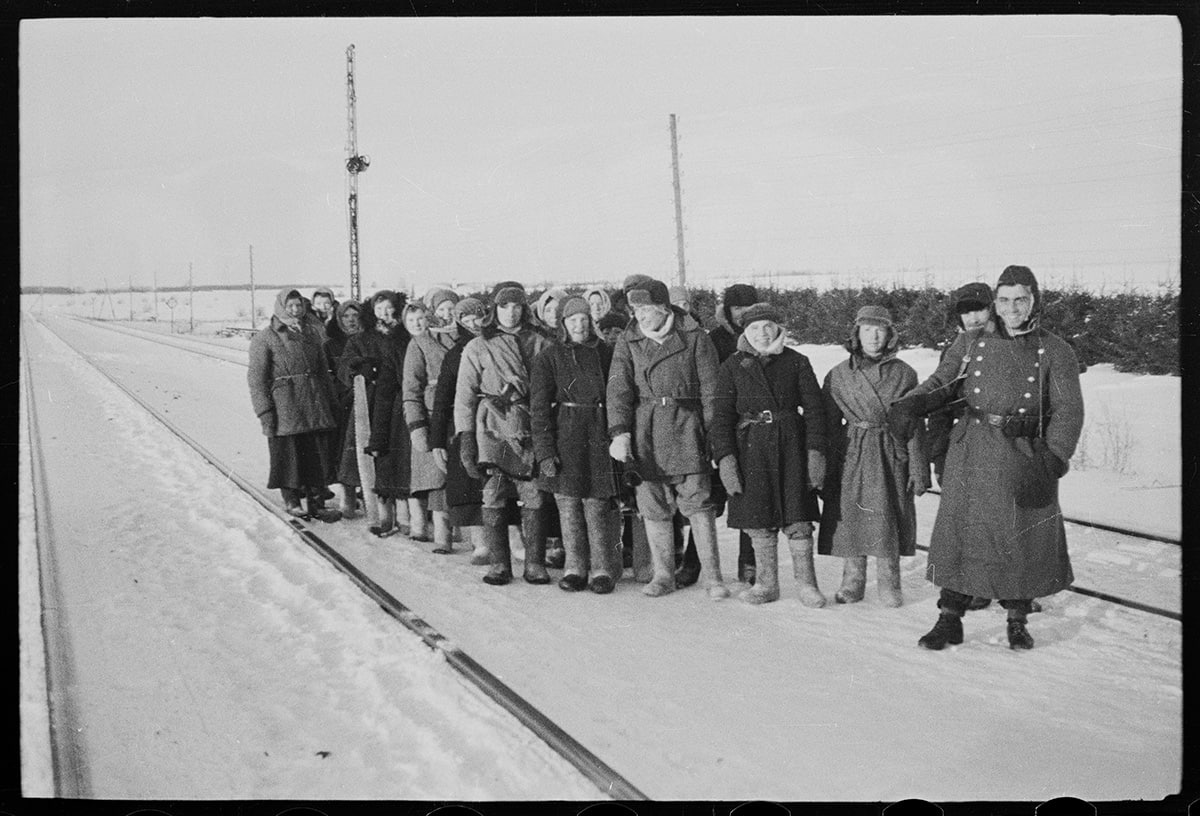
Group portrait of young boys and girls with a German escort. Judging by the saw in the girl's hands, they were engaged in work in the forest. Most of the men joined the Soviet army or partisans. Vitebsk region, Belarus, USSR. Winter 1941-42
Group portrait of young boys and girls with a German escort. Judging by the saw in the girl's hands, they were engaged in work in the forest. Most of the men joined the Soviet army or partisans. Vitebsk region, Belarus, USSR. Winter 1941-42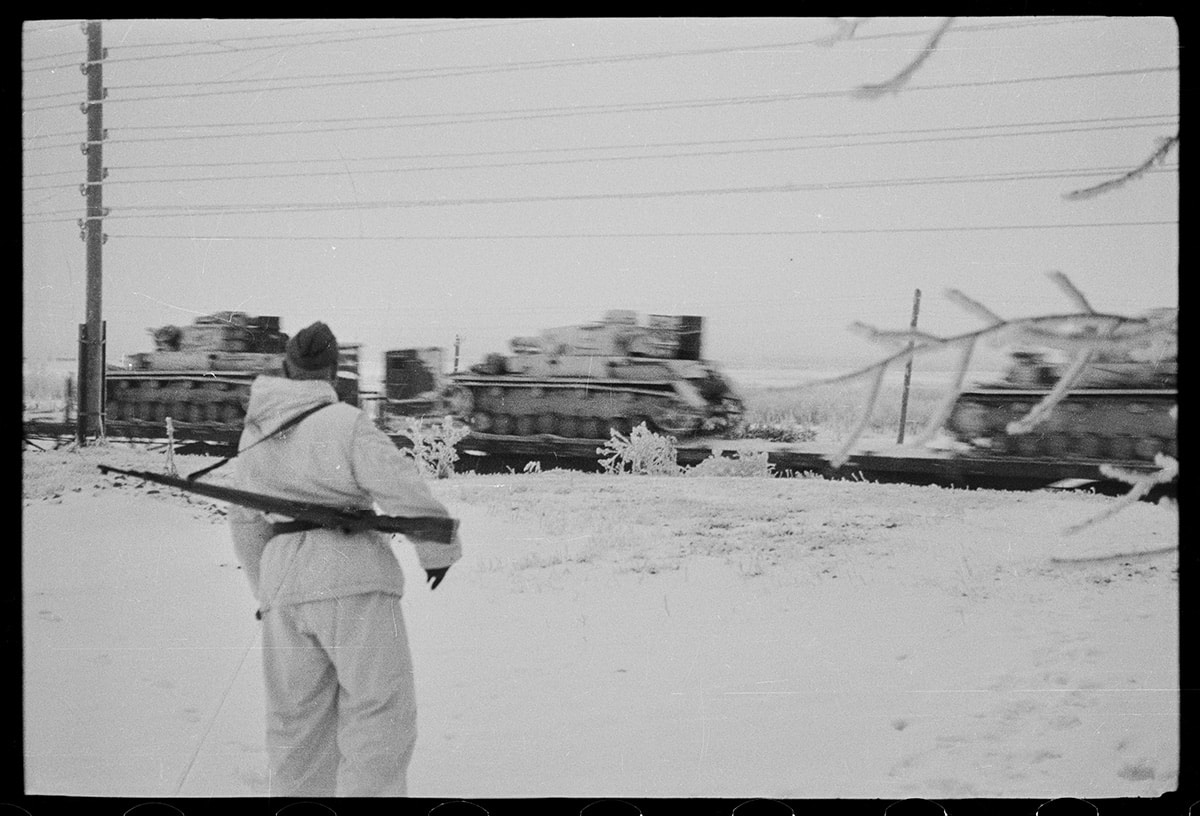
A German soldier watches as German PzKpfw IV medium tanks (also known as "T-IV" in the USSR) in winter camouflage are transported on railway platforms to the Eastern Front. On the German soldier's shoulder is a Mauser 98k magazine rifle. Vitebsk region, Belarus, USSR. Winter 1941-42
A German soldier watches as German PzKpfw IV medium tanks (also known as "T-IV" in the USSR) in winter camouflage are transported on railway platforms to the Eastern Front. On the German soldier's shoulder is a Mauser 98k magazine rifle. Vitebsk region, Belarus, USSR. Winter 1941-42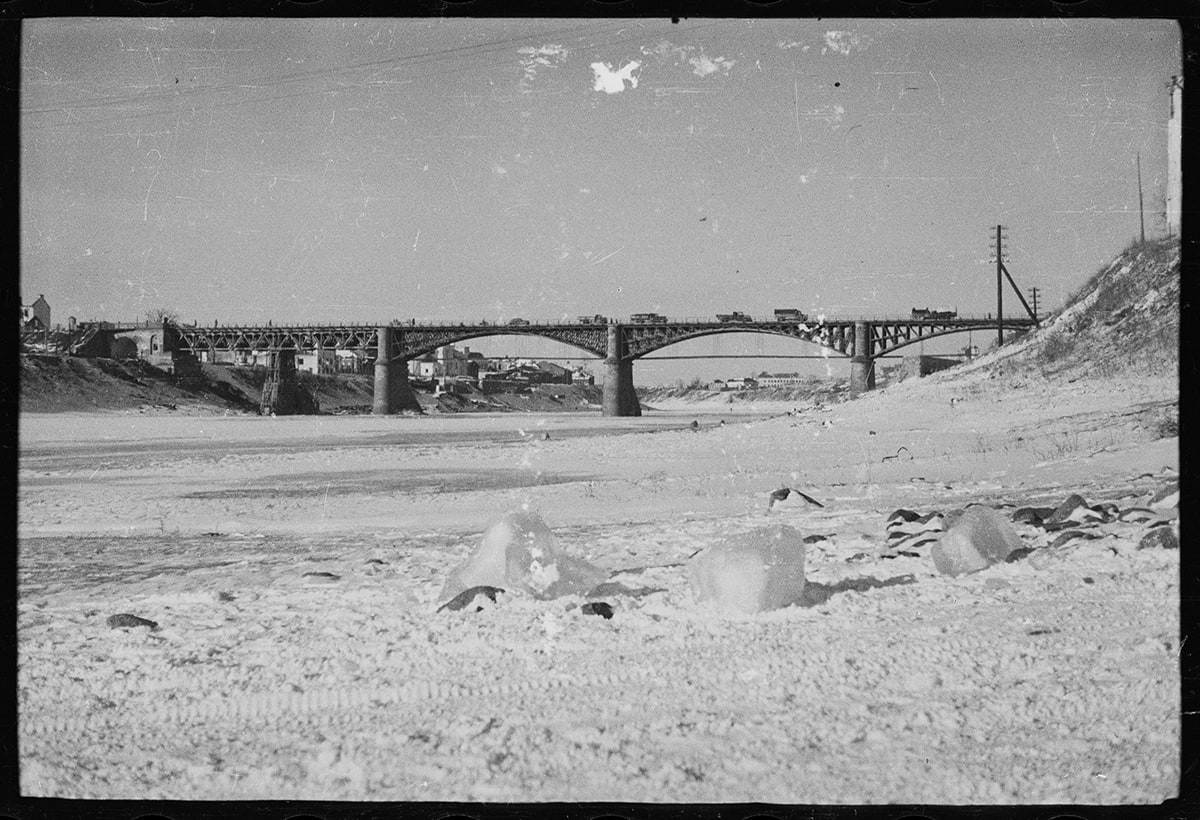
German military equipment moving on the Dvinskiy Bridge (future Blokhin Bridge) over the Western Dvina River repaired by the Germans. Vitebsk, Belarus, USSR. Winter 1941-42
German military equipment moving on the Dvinskiy Bridge (future Blokhin Bridge) over the Western Dvina River repaired by the Germans. Vitebsk, Belarus, USSR. Winter 1941-42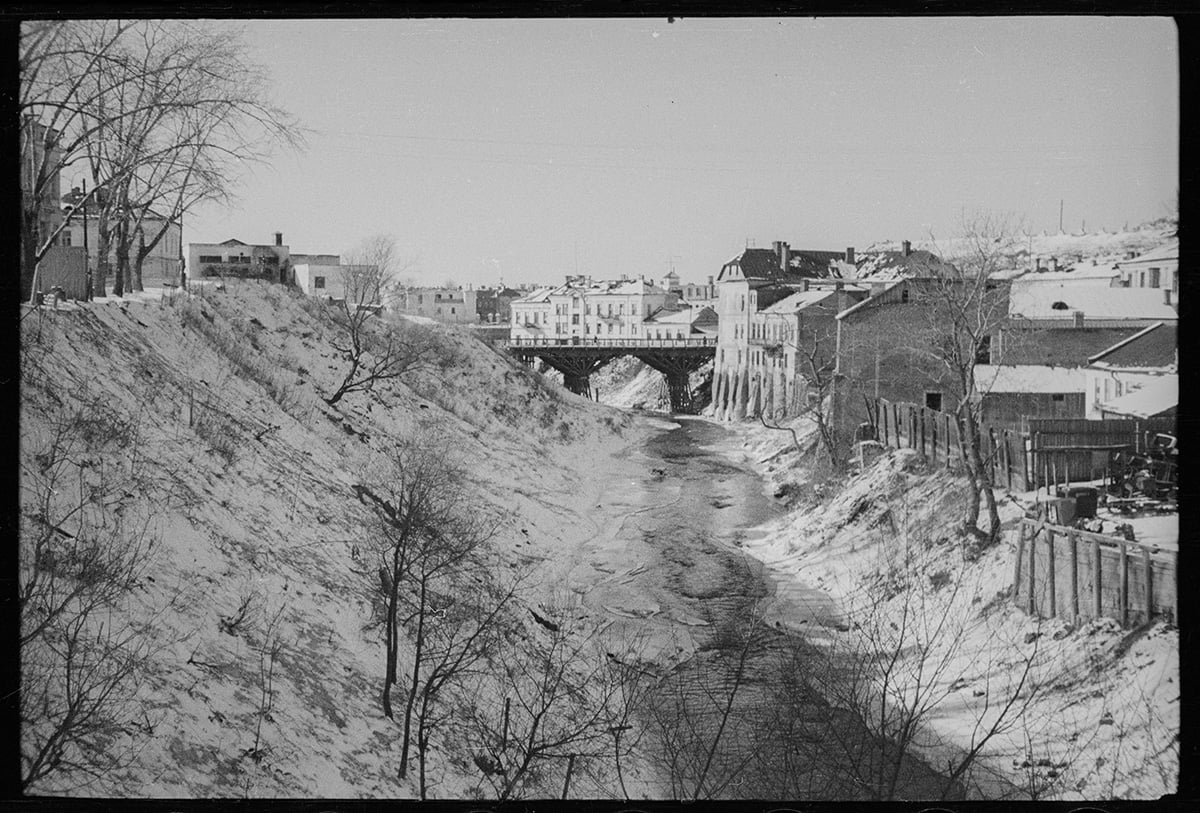
Bridge over the Vitba River, left tributary of the Zapadnaya Dvina River. Vitebsk, Belarus, USSR. Winter 1941-42
Bridge over the Vitba River, left tributary of the Zapadnaya Dvina River. Vitebsk, Belarus, USSR. Winter 1941-42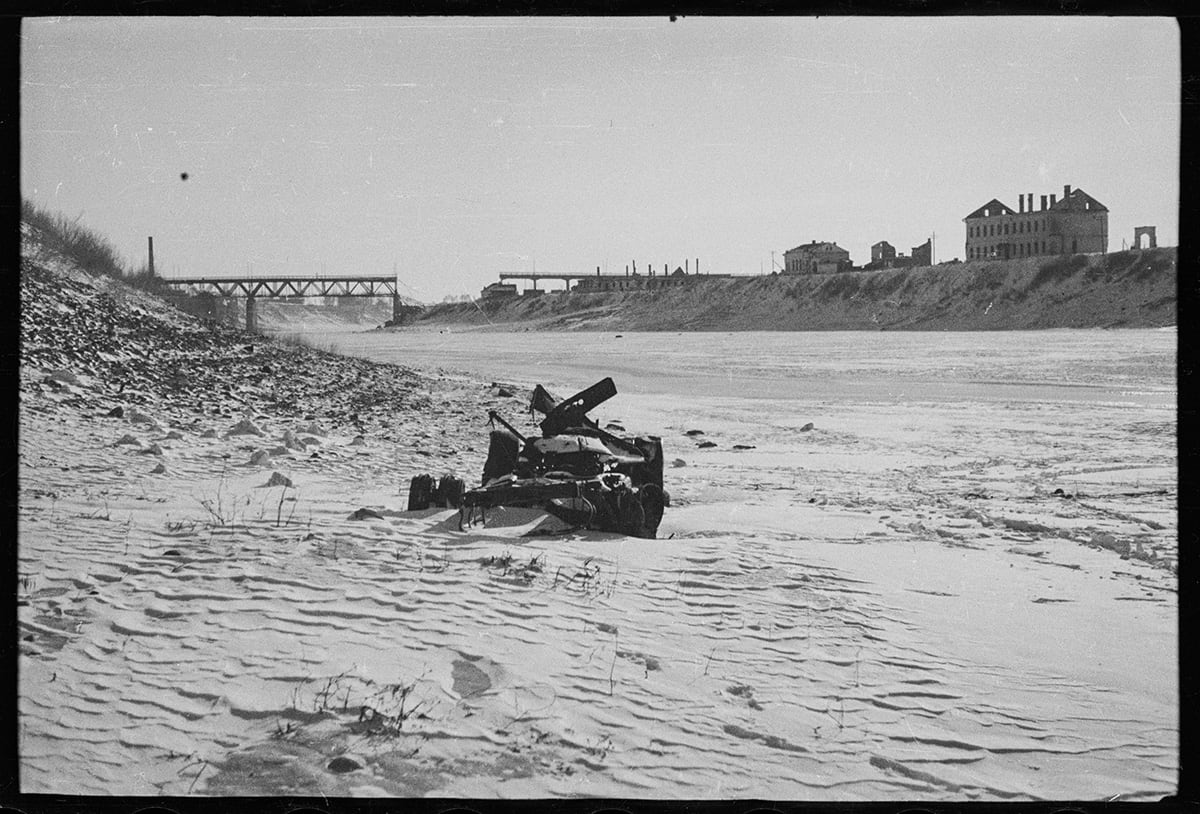
Remains of a Soviet truck on the bank of the Zapadnaya Dvina River. The destroyed Novy Bridge (future Blokhin Bridge) is seen in the background. Vitebsk, Belarus, USSR. Winter 1941-42
Remains of a Soviet truck on the bank of the Zapadnaya Dvina River. The destroyed Novy Bridge (future Blokhin Bridge) is seen in the background. Vitebsk, Belarus, USSR. Winter 1941-42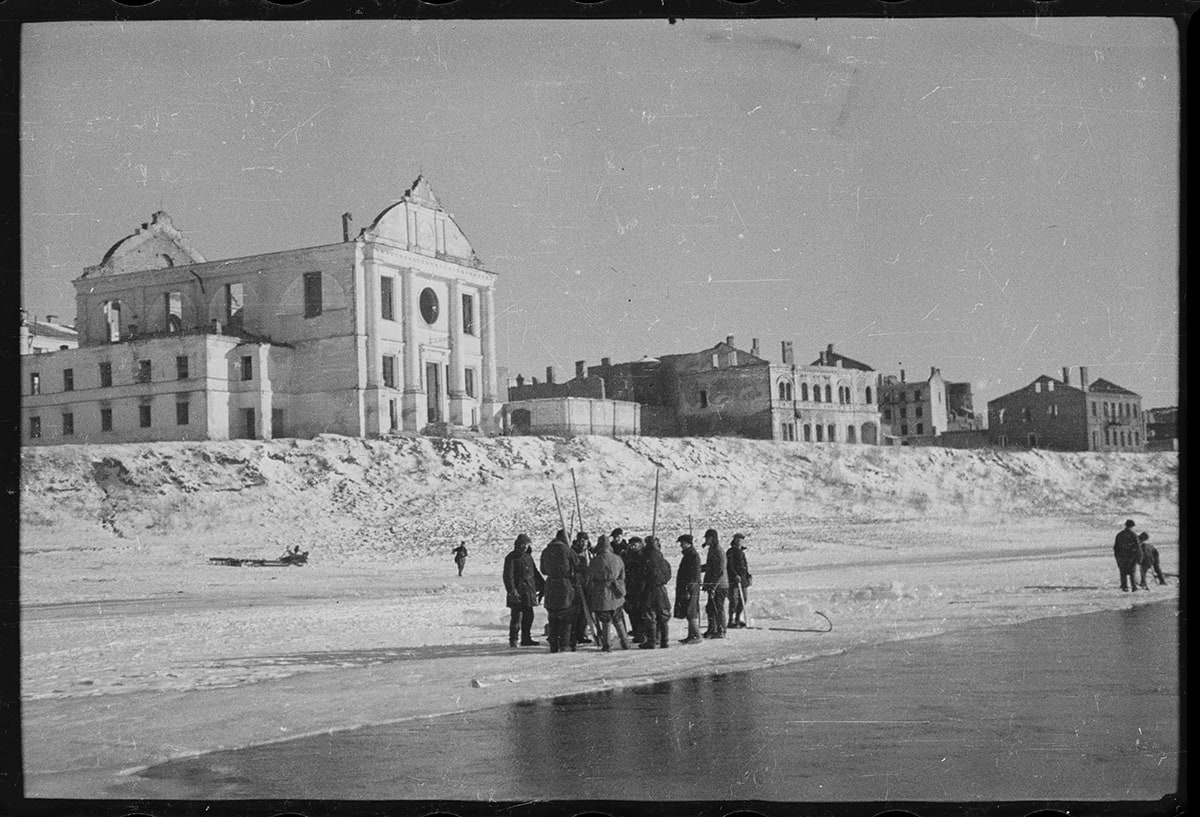
A group of men with axes, hoes and other tools for chopping ice on the partially frozen Western Dvina River. Ruins of destroyed buildings can be seen on the shore. Vitebsk, Belarus, USSR. Winter 1941-42
A group of men with axes, hoes and other tools for chopping ice on the partially frozen Western Dvina River. Ruins of destroyed buildings can be seen on the shore. Vitebsk, Belarus, USSR. Winter 1941-42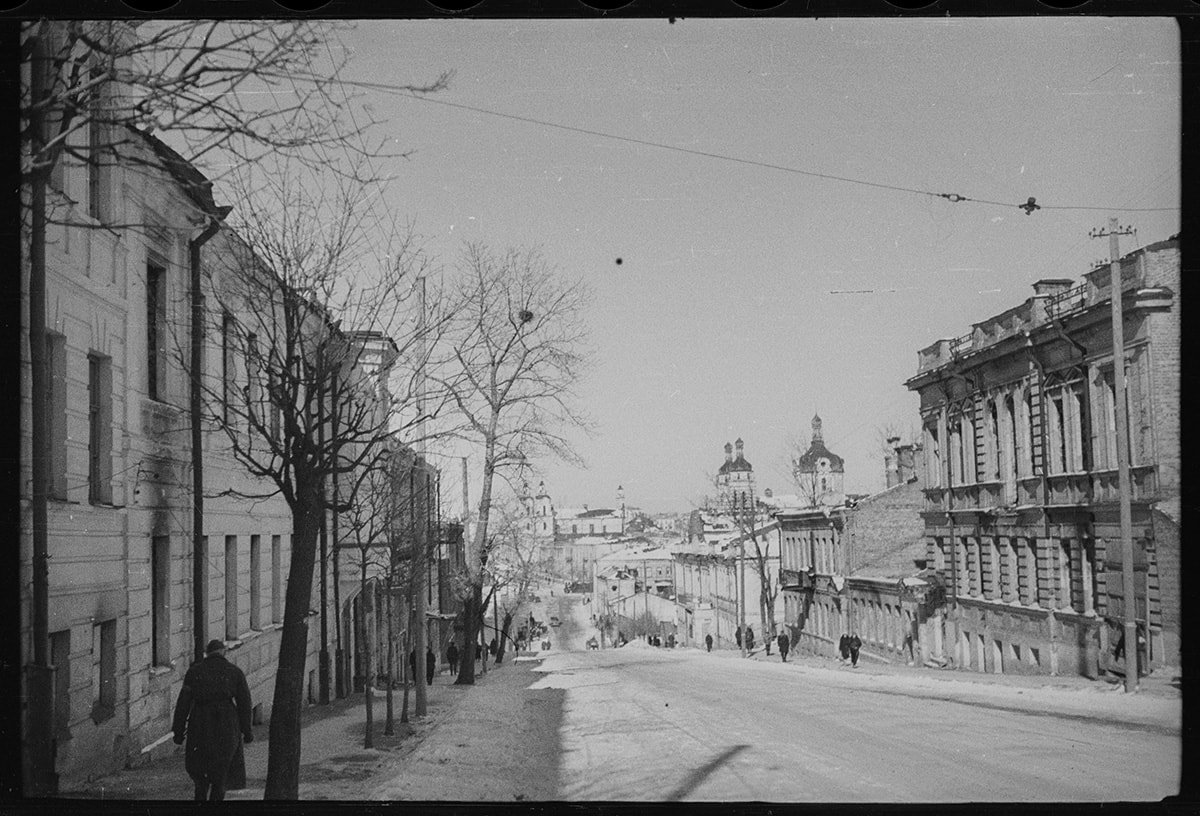
Castle Street. St. Nicholas Cathedral and St. Anthony's Church can be seen in the distance. Vitebsk, Belarus, USSR. Winter 1941-42
Castle Street. St. Nicholas Cathedral and St. Anthony's Church can be seen in the distance. Vitebsk, Belarus, USSR. Winter 1941-42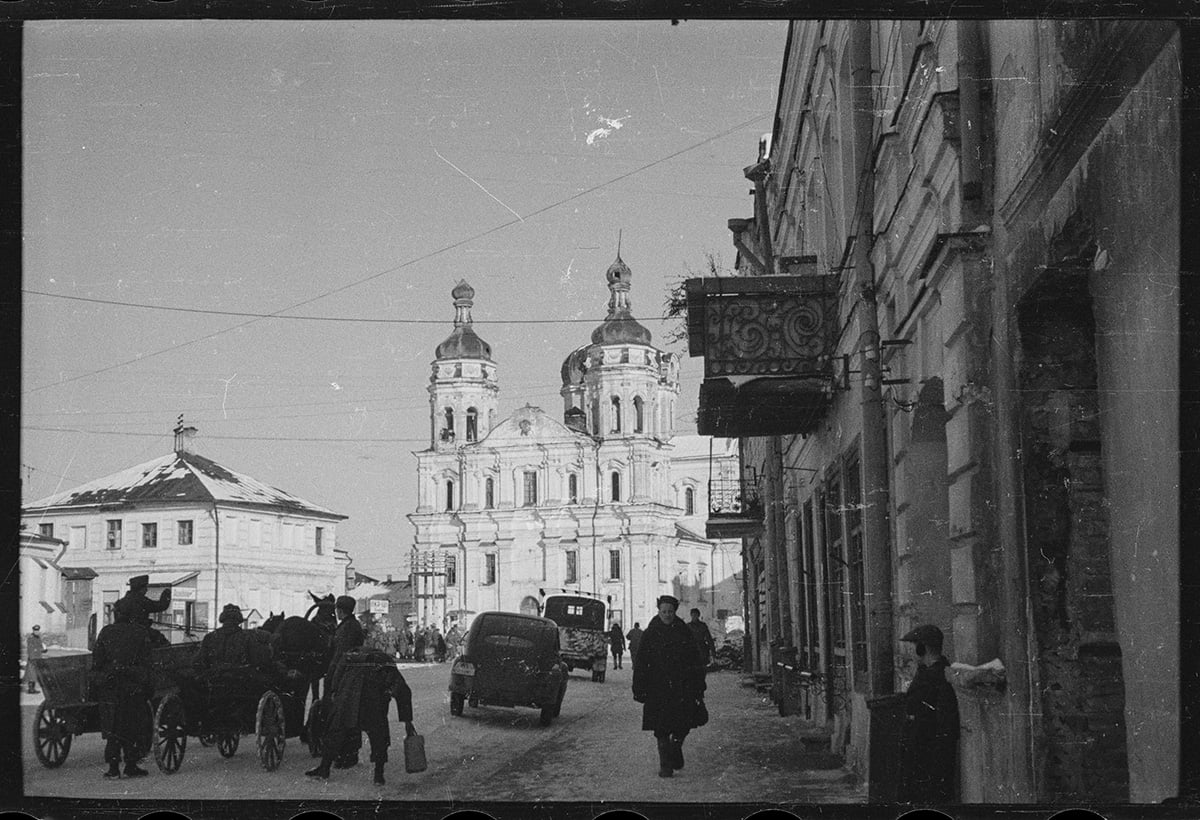
Zamkovaya Street and Nikolayevsky Cathedral. Vitebsk, Belarus, USSR. Winter 1941-42
Zamkovaya Street and Nikolayevsky Cathedral. Vitebsk, Belarus, USSR. Winter 1941-42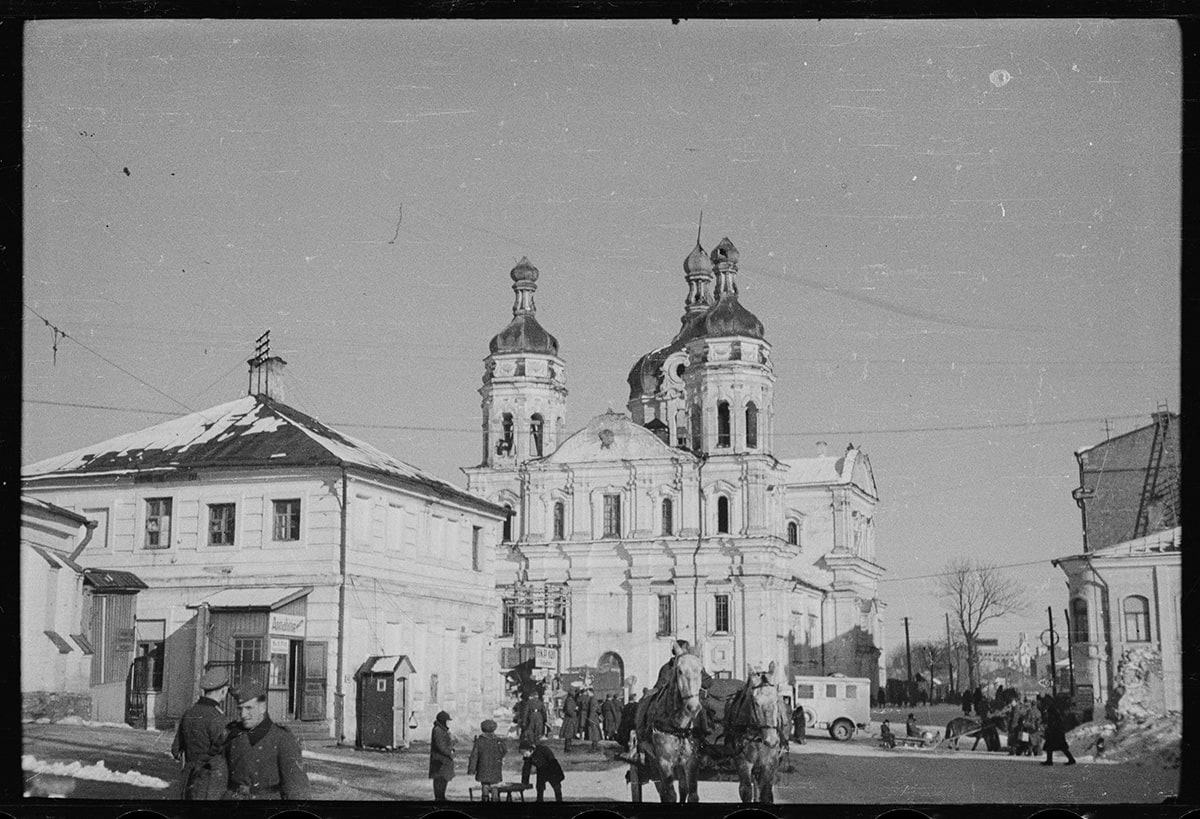
Zamkovaya Street and Nikolayevsky Cathedral. Vitebsk, Belarus, USSR. Winter 1941-42
Zamkovaya Street and Nikolayevsky Cathedral. Vitebsk, Belarus, USSR. Winter 1941-42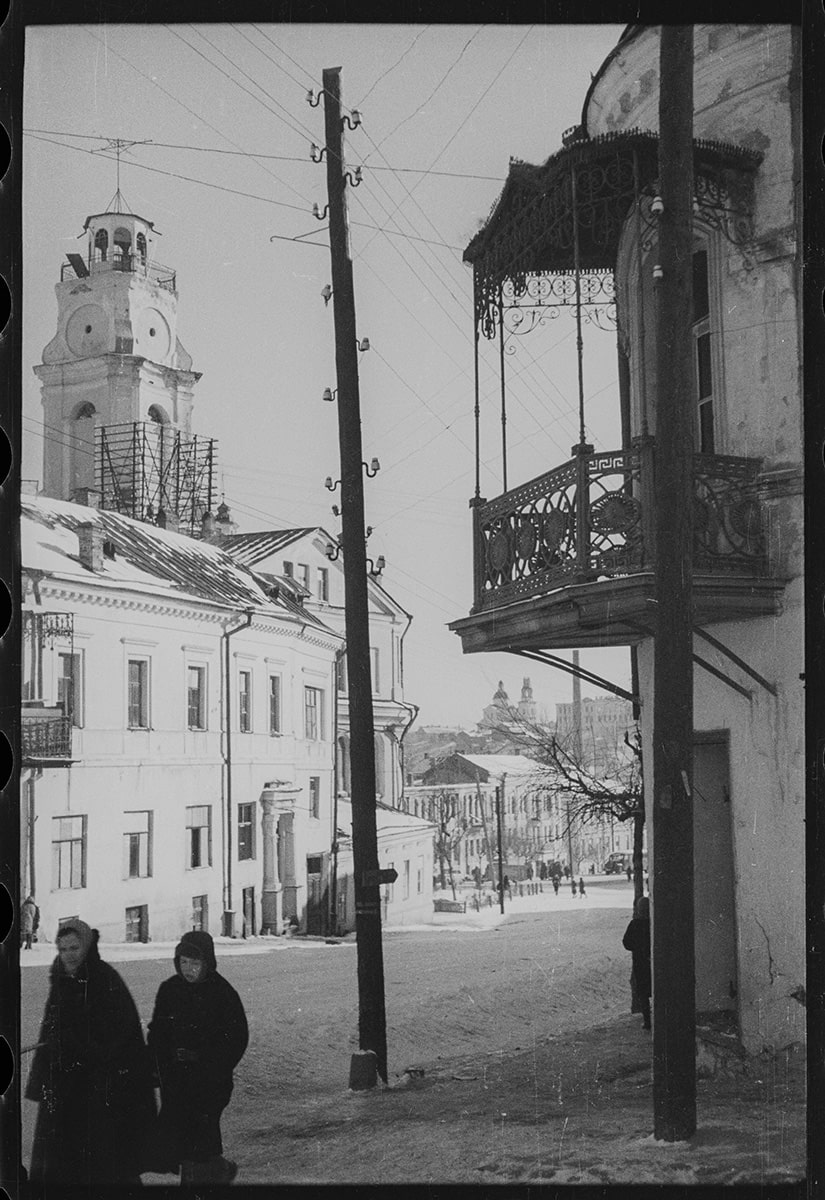
Zamkovaya street. Vitebsk, Belarus, USSR. Winter 1941-42
Zamkovaya street. Vitebsk, Belarus, USSR. Winter 1941-42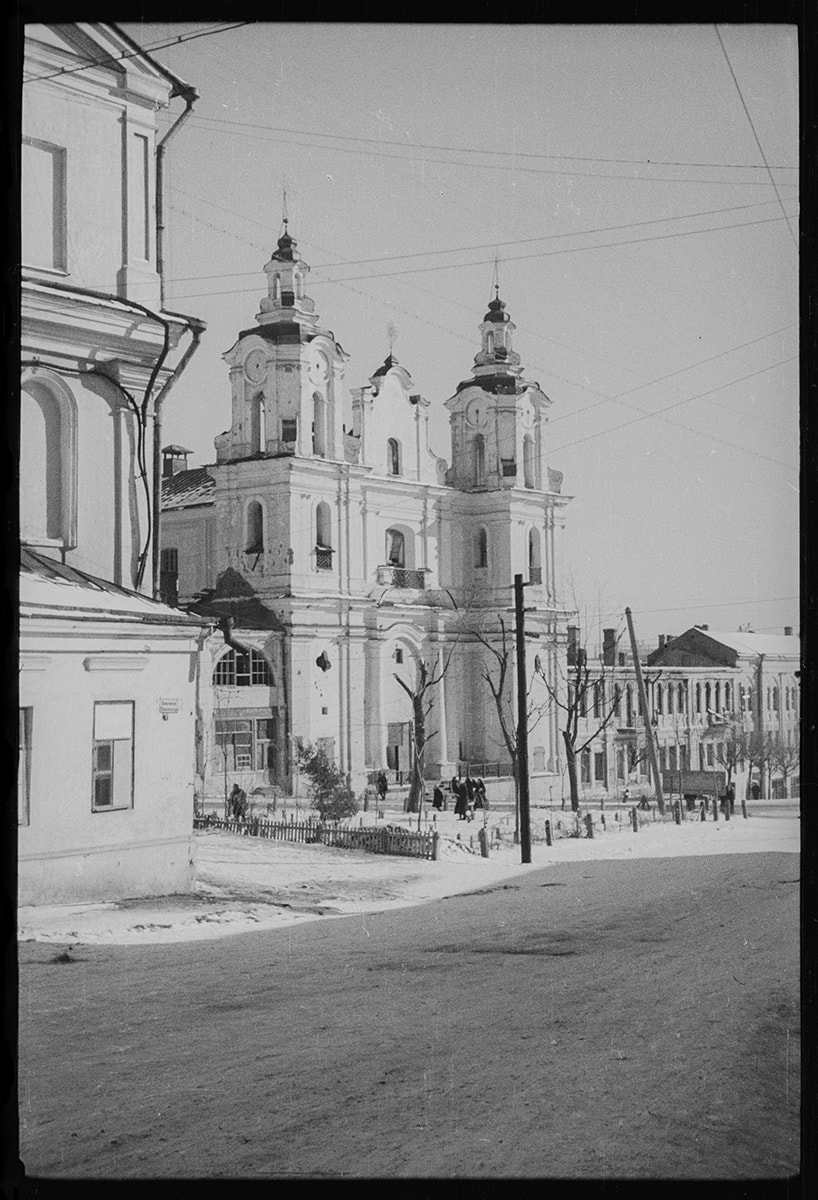
St. Anthony's Church on Lenin Street. Vitebsk, Belarus, USSR. Winter 1941-42
St. Anthony's Church on Lenin Street. Vitebsk, Belarus, USSR. Winter 1941-42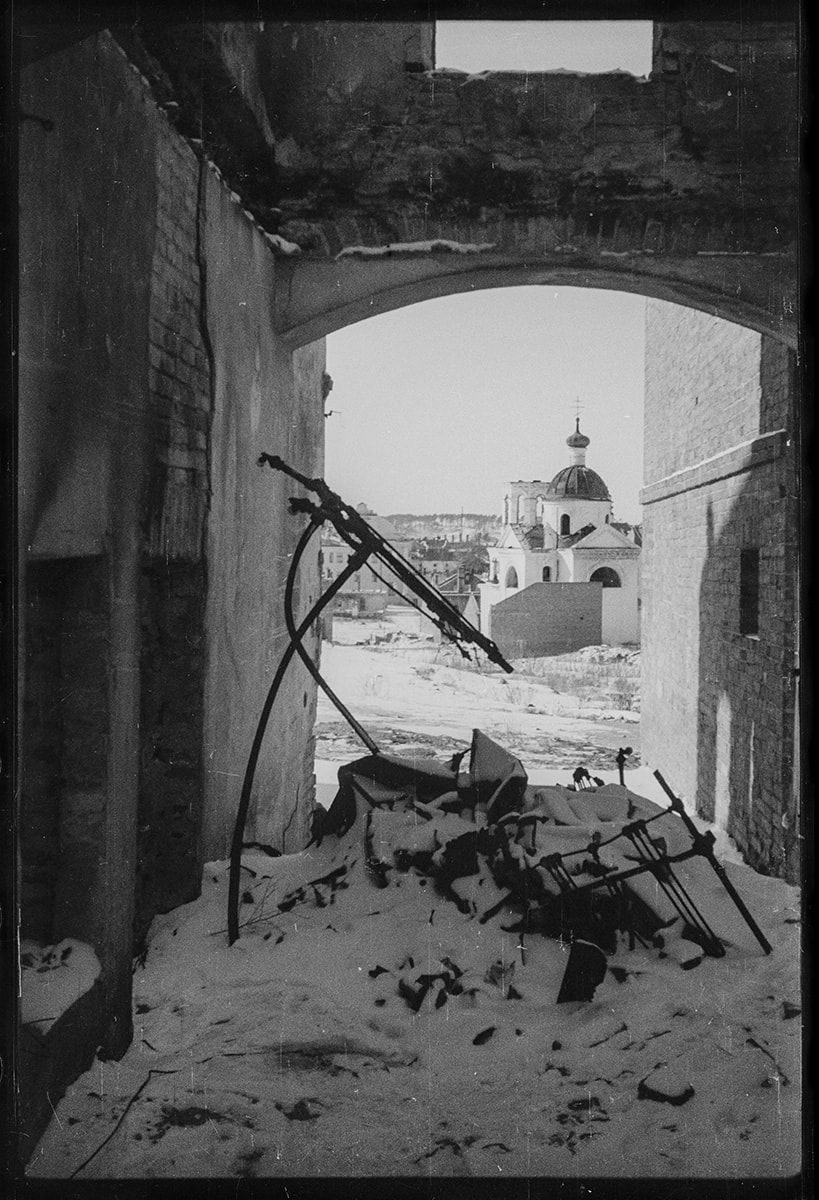
View of the Nativity Church or Church of the Nativity through the opening of a destroyed apartment building. Vitebsk, Belarus, USSR. Winter 1941-42
View of the Nativity Church or Church of the Nativity through the opening of a destroyed apartment building. Vitebsk, Belarus, USSR. Winter 1941-42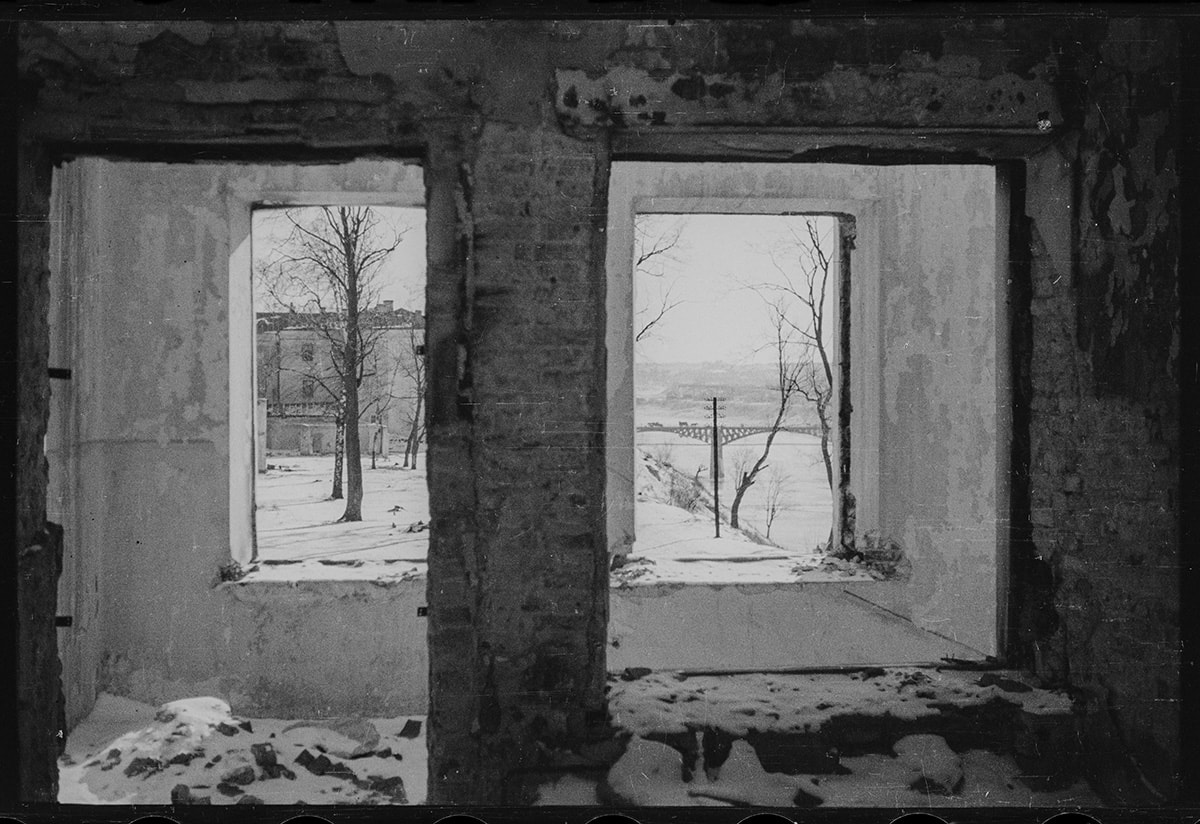
View of Dvinsky Bridge (future Blokhin Bridge) through the window openings of a building destroyed by the Germans. Vitebsk, Belarus, USSR. Winter 1941-42
View of Dvinsky Bridge (future Blokhin Bridge) through the window openings of a building destroyed by the Germans. Vitebsk, Belarus, USSR. Winter 1941-42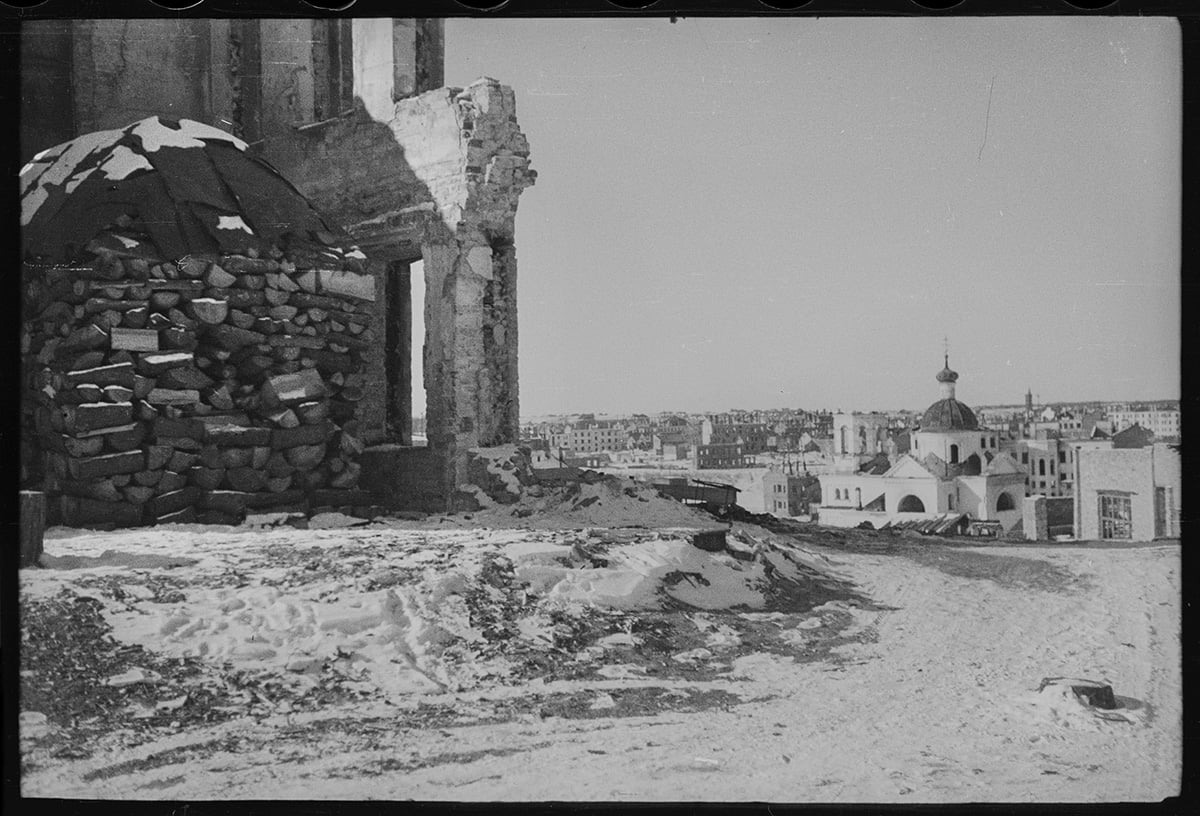
View of the Nativity Church or Church of the Nativity of Christ. Vitebsk, Belarus, USSR. Winter 1941-42
View of the Nativity Church or Church of the Nativity of Christ. Vitebsk, Belarus, USSR. Winter 1941-42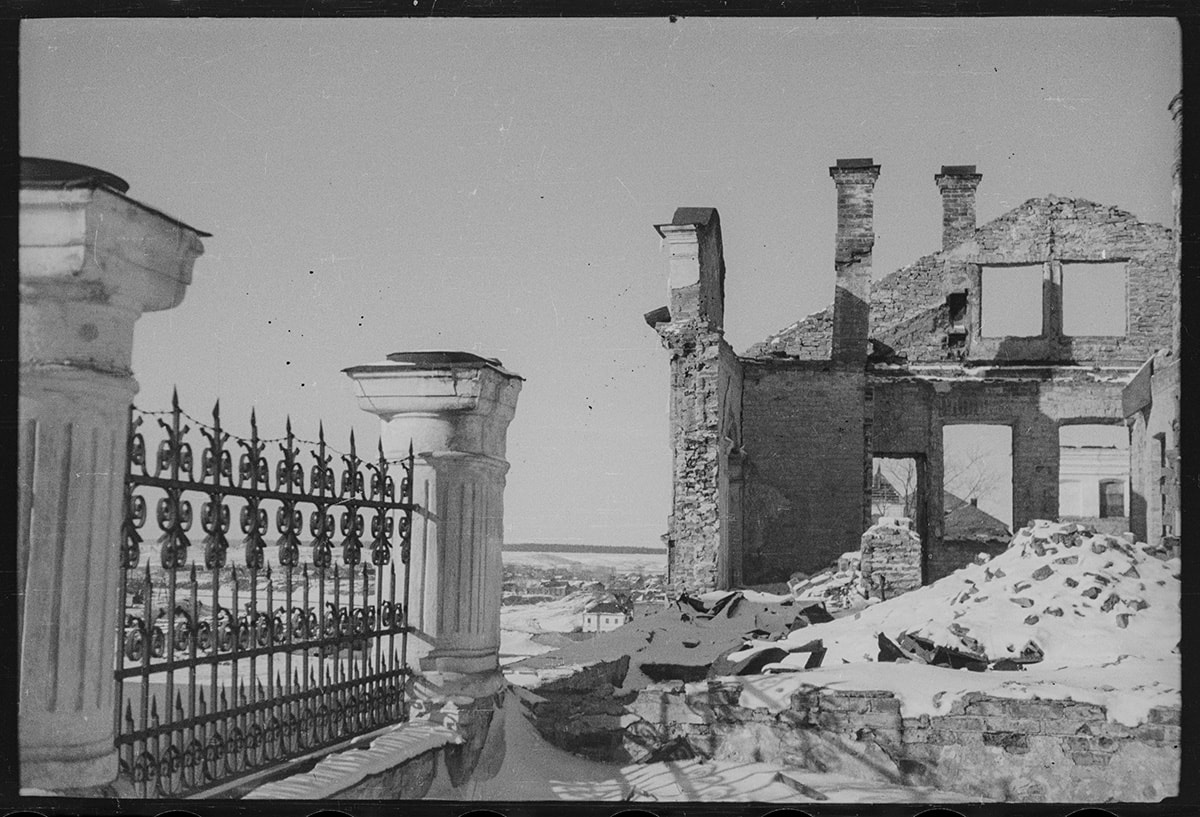
Ruins of one of the destroyed churches. Vitebsk, Belarus, USSR. Winter 1941-42
Ruins of one of the destroyed churches. Vitebsk, Belarus, USSR. Winter 1941-42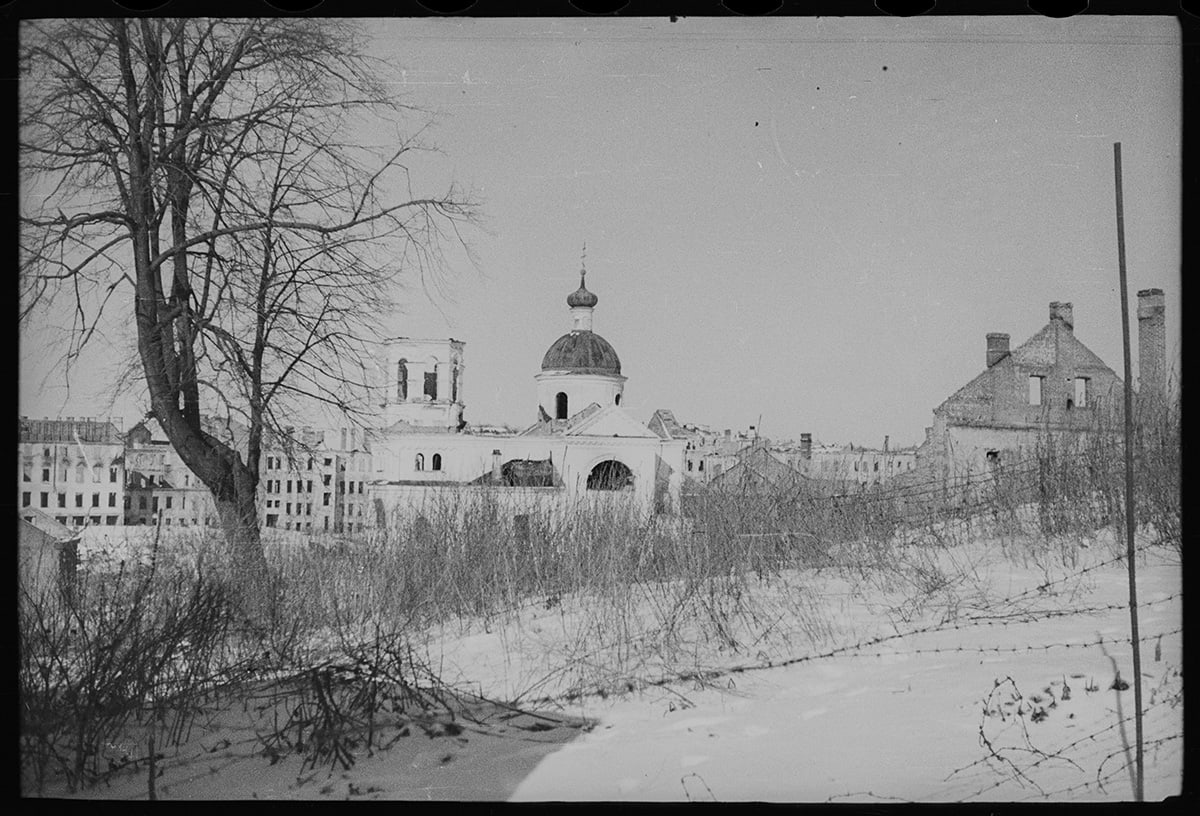
View of the Nativity Church or Church of the Nativity of Christ. Vitebsk, Belarus, USSR. Winter 1941-42
View of the Nativity Church or Church of the Nativity of Christ. Vitebsk, Belarus, USSR. Winter 1941-42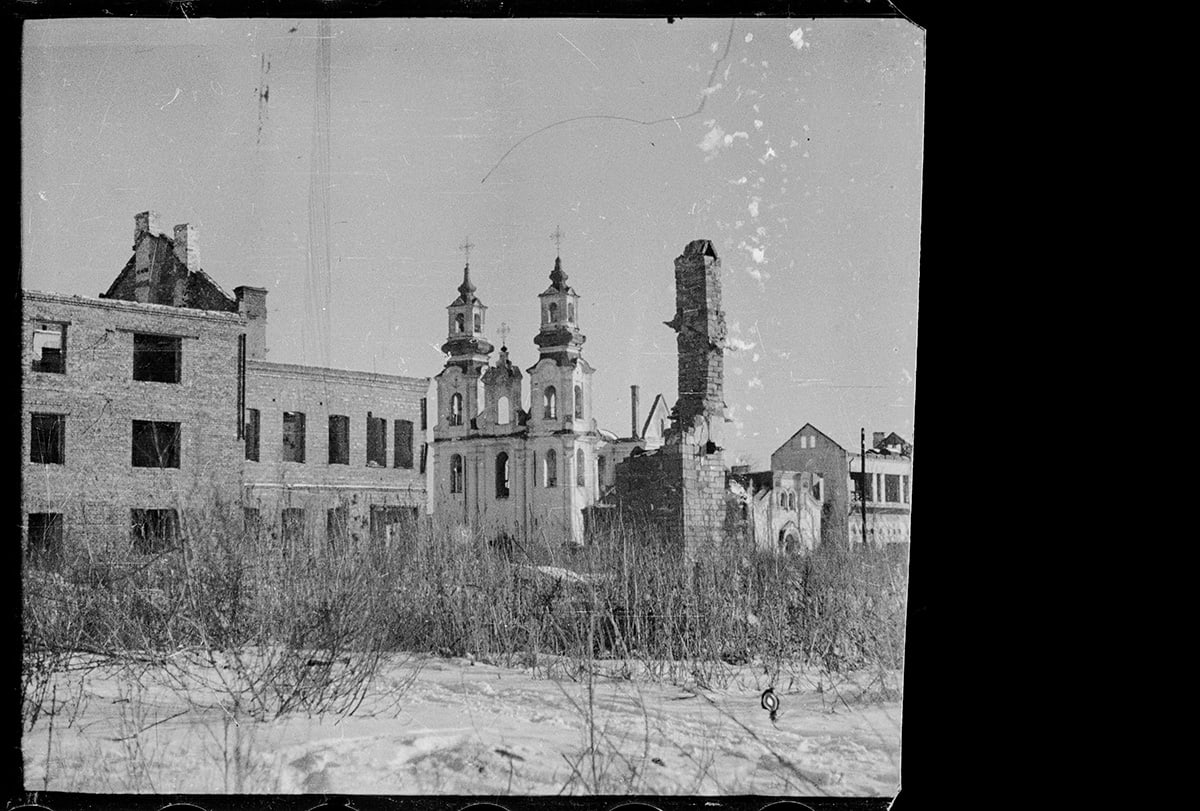
Ruins of residential buildings against the background of St. Anthony's Church. Vitebsk, Belarus, USSR. Winter 1941-42
Ruins of residential buildings against the background of St. Anthony's Church. Vitebsk, Belarus, USSR. Winter 1941-42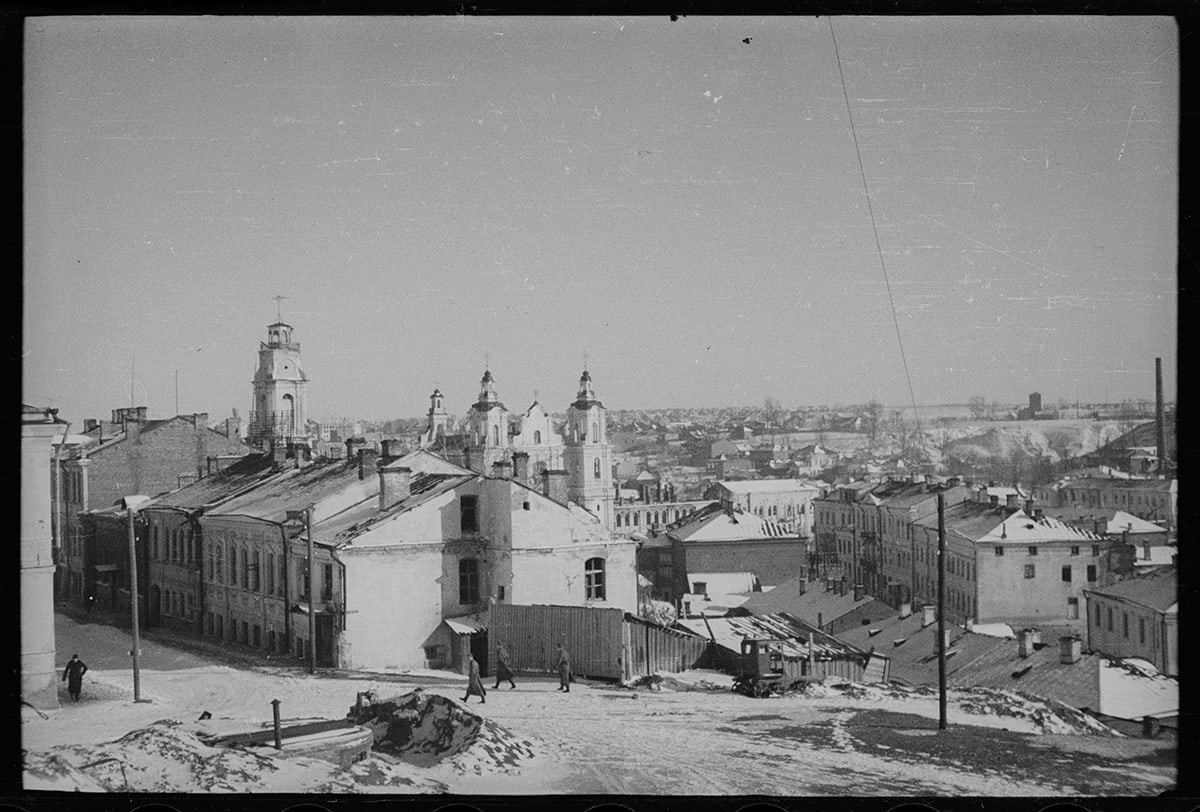
A panorama of the occupied city. St. Anthony's Church is seen in the background. Vitebsk, Belarus, USSR. Winter 1941-42
A panorama of the occupied city. St. Anthony's Church is seen in the background. Vitebsk, Belarus, USSR. Winter 1941-42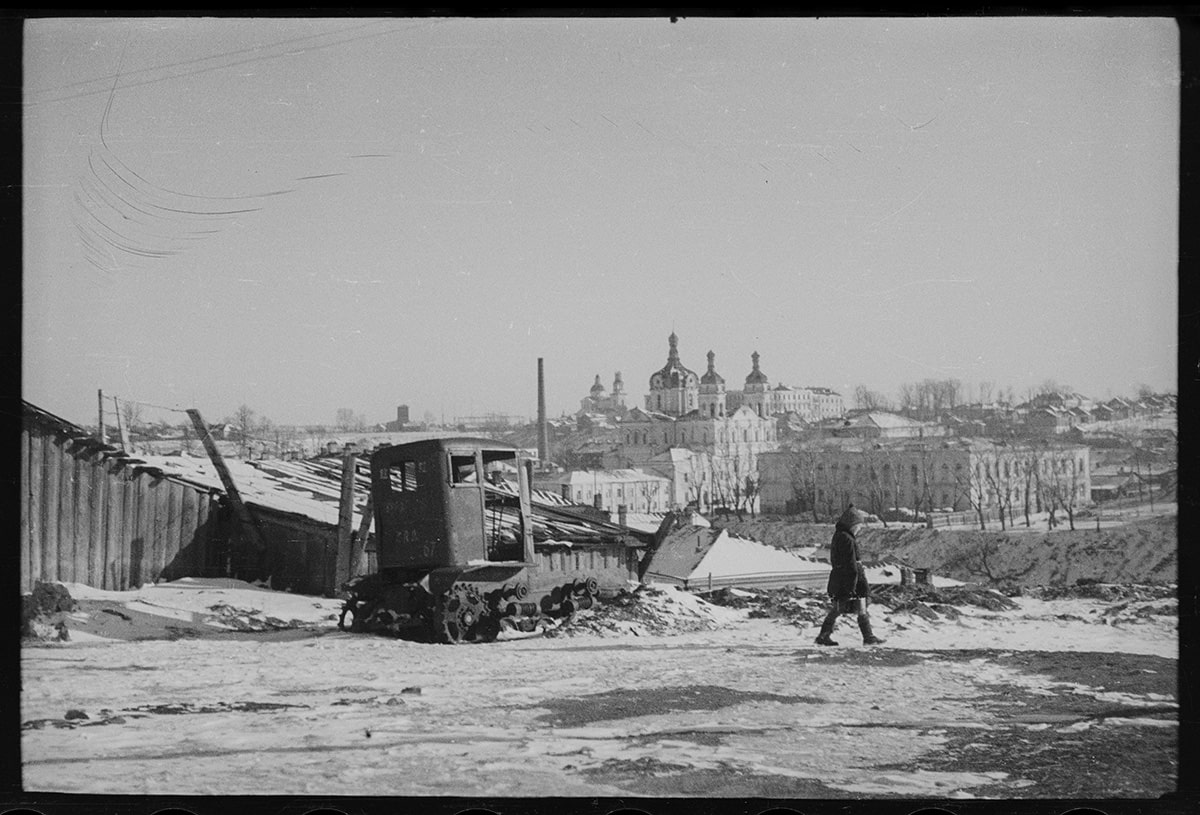
A child carrying water against the background of a broken Soviet tractor. St. Nicholas Cathedral is seen in the distance. Vitebsk, Belarus, USSR. Winter 1941-42
A child carrying water against the background of a broken Soviet tractor. St. Nicholas Cathedral is seen in the distance. Vitebsk, Belarus, USSR. Winter 1941-42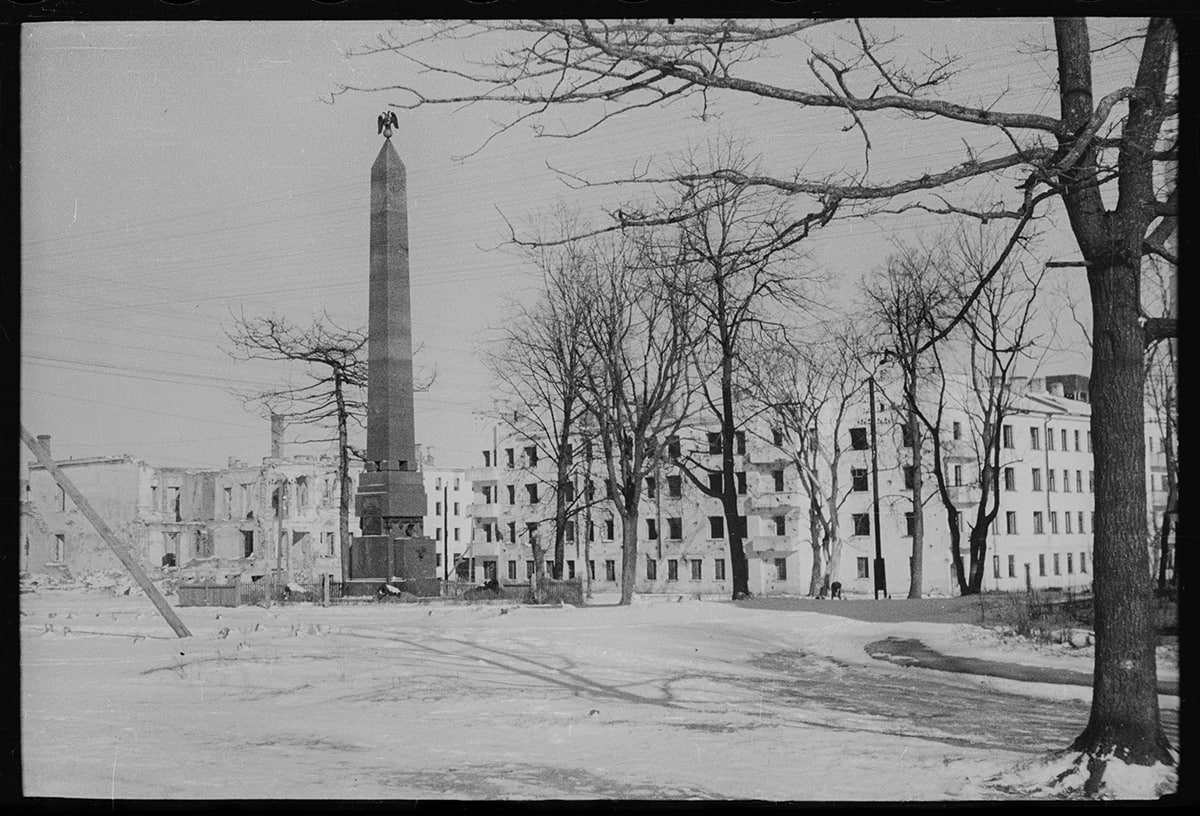
Obelisk to the heroes of the Patriotic War of 1812 at the end of Sovetskaya Street with destroyed houses in the background. Vitebsk, Belarus, USSR. Winter 1941-42
Obelisk to the heroes of the Patriotic War of 1812 at the end of Sovetskaya Street with destroyed houses in the background. Vitebsk, Belarus, USSR. Winter 1941-42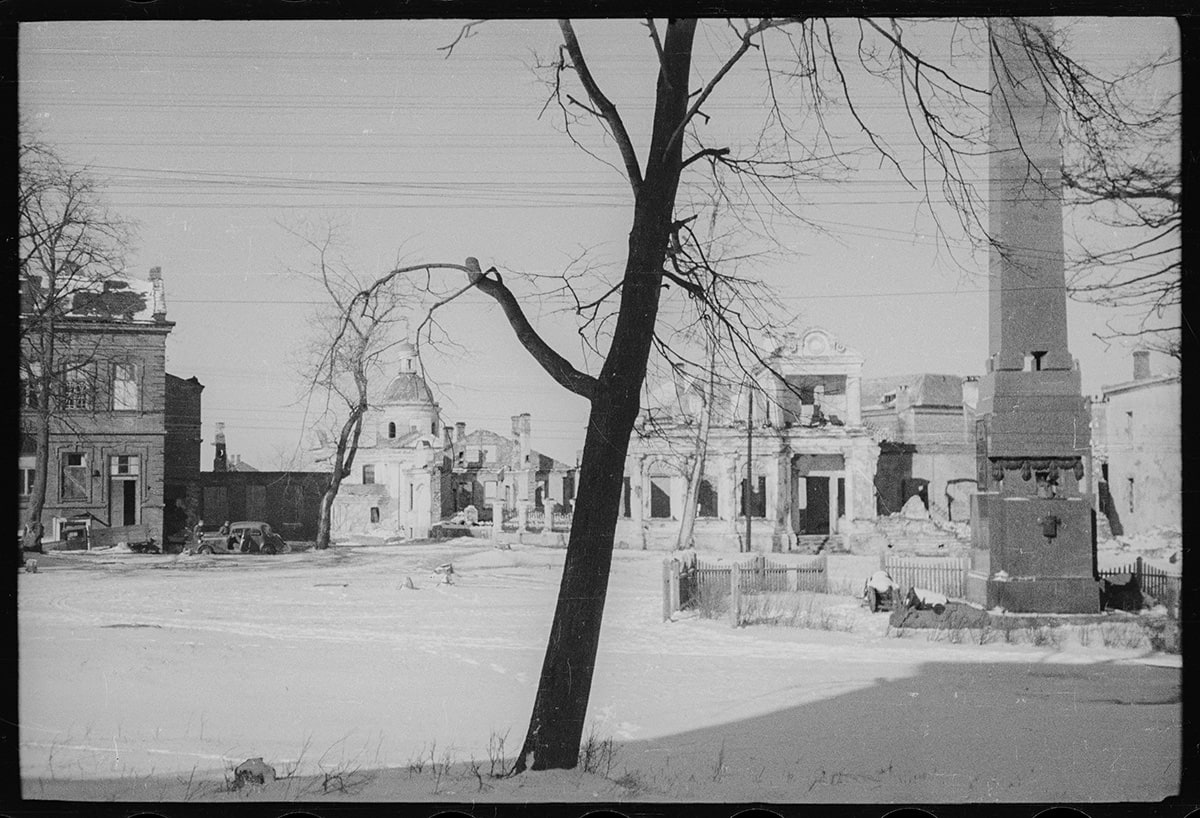
Obelisk to the heroes of the Patriotic War of 1812 at the end of Sovetskaya Street with destroyed houses in the background. Vitebsk, Belarus, USSR. Winter 1941-42
Obelisk to the heroes of the Patriotic War of 1812 at the end of Sovetskaya Street with destroyed houses in the background. Vitebsk, Belarus, USSR. Winter 1941-42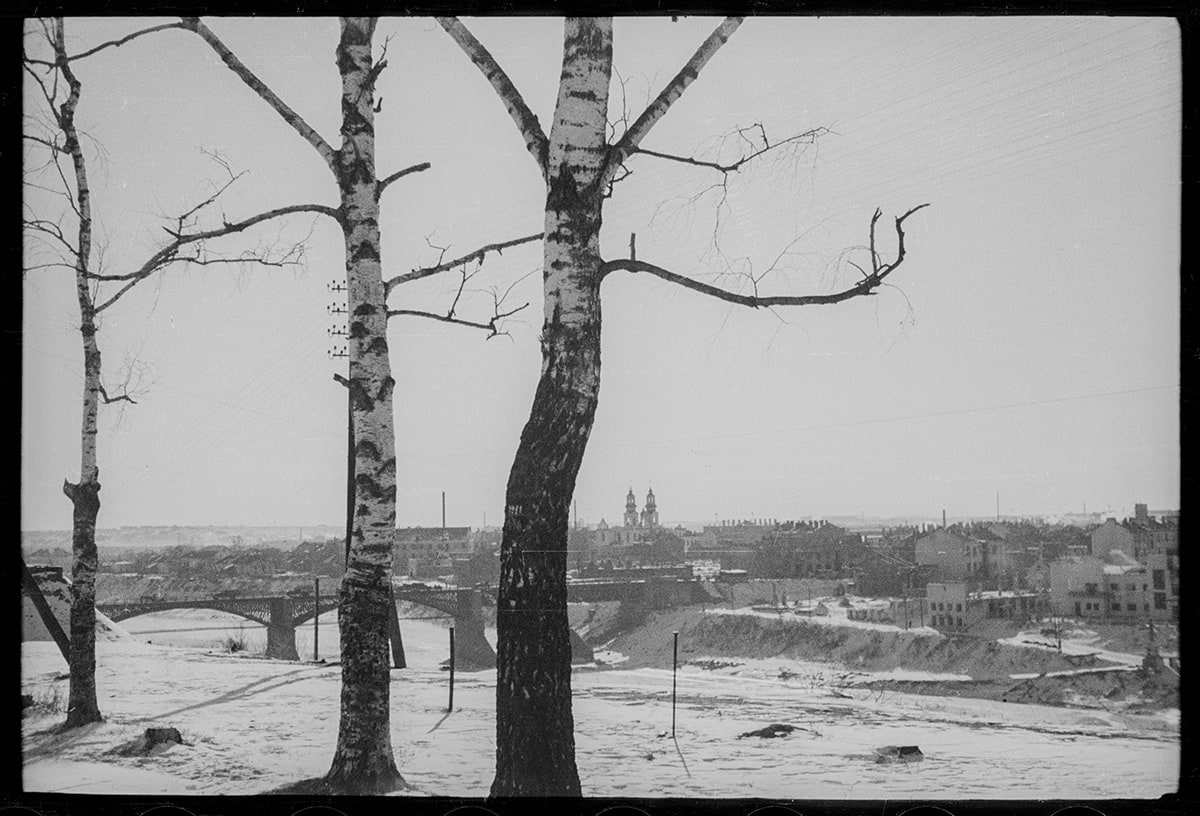
Panorama of the occupied and partially destroyed city on the left bank of the Western Dvina River. The Dvinsky Bridge (future Blokhin Bridge) repaired by the Germans is seen moving machinery. Vitebsk, Belarus, USSR. Winter 1941-42
Panorama of the occupied and partially destroyed city on the left bank of the Western Dvina River. The Dvinsky Bridge (future Blokhin Bridge) repaired by the Germans is seen moving machinery. Vitebsk, Belarus, USSR. Winter 1941-42